Highlights of the Amsterdam Pipe Museum
Author:
Don Duco
Original Title:
Hoogtepunten uit het Amsterdam Pipe Museum
Publication Year:
2020
Publisher:
Amsterdam Pipe Museum (Stichting Pijpenkabinet)
A woman's leg as a pipe stopper
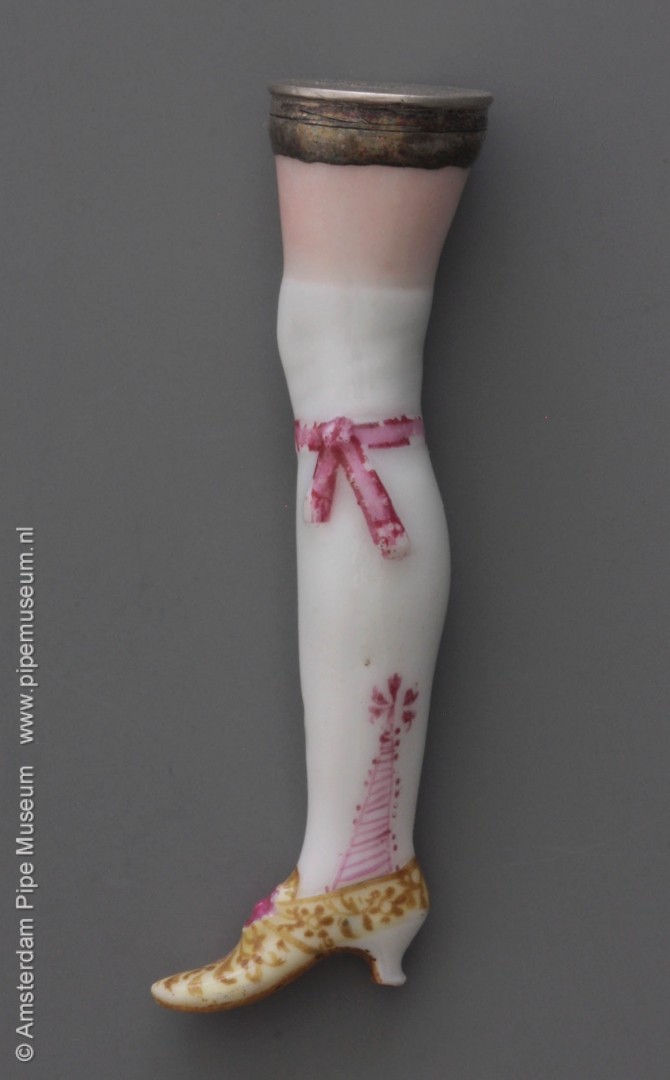
Every smoker knows that for the right draft in the pipe one should use a so-called pipe stopper or pipe tamper. It is a simple instrument with a flattened bottom to give pressure to the tobacco in the pipe bowl during smoking. This is necessary because during smoking the tobacco dries out and becomes loosened, so that the right resistance to a nice smoldering fire is likely to disappear. Pipe stoppers have been made since the seventeenth century. Initially very small because the diameter of the bowl opening was less than half an inch. Sometimes even that stopper was soldered to the hinge of the tobacco box in order not to get lost.
In the eighteenth century, the most luxury pipe stoppers were made, as the example shown here. It is a porcelain object from the famous Meissen factory. The stopper is made in the shape of a woman's leg, the English speak of a maiden's leg. The fashionable shoe with heel does not seem to be a simple fashion item, but rather the footwear of a true lady. The object was cast and then covered with colourful paint. The shoe is minutiously painted with embroidery in brown.
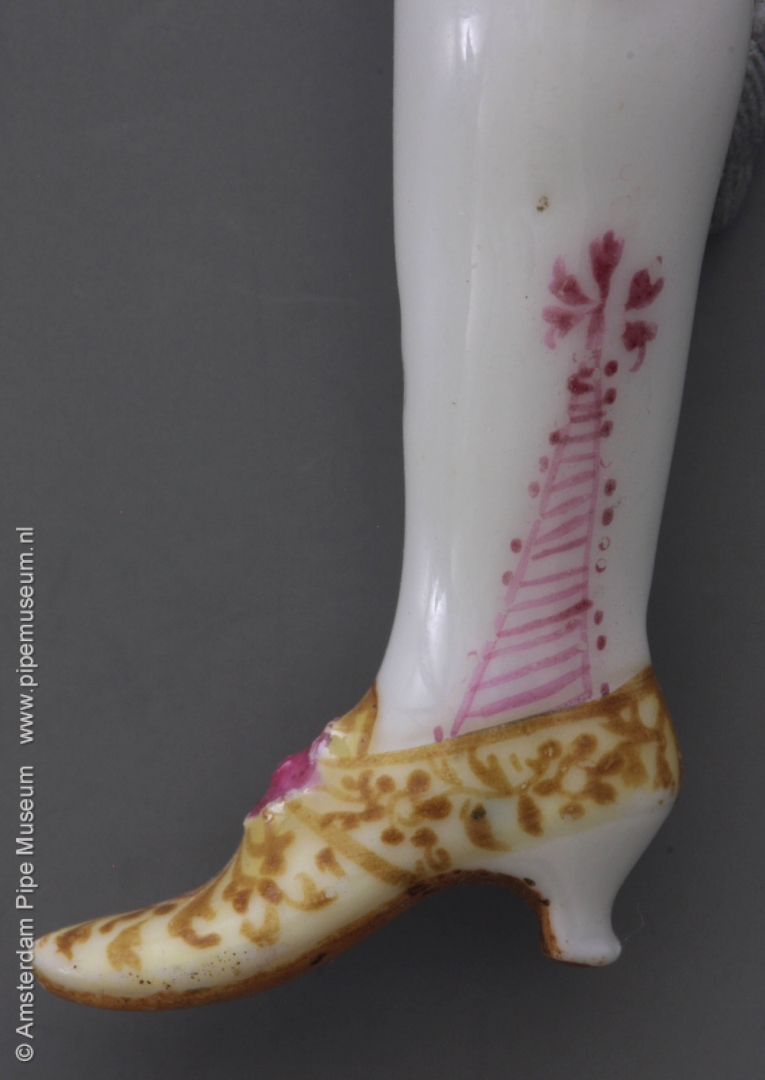
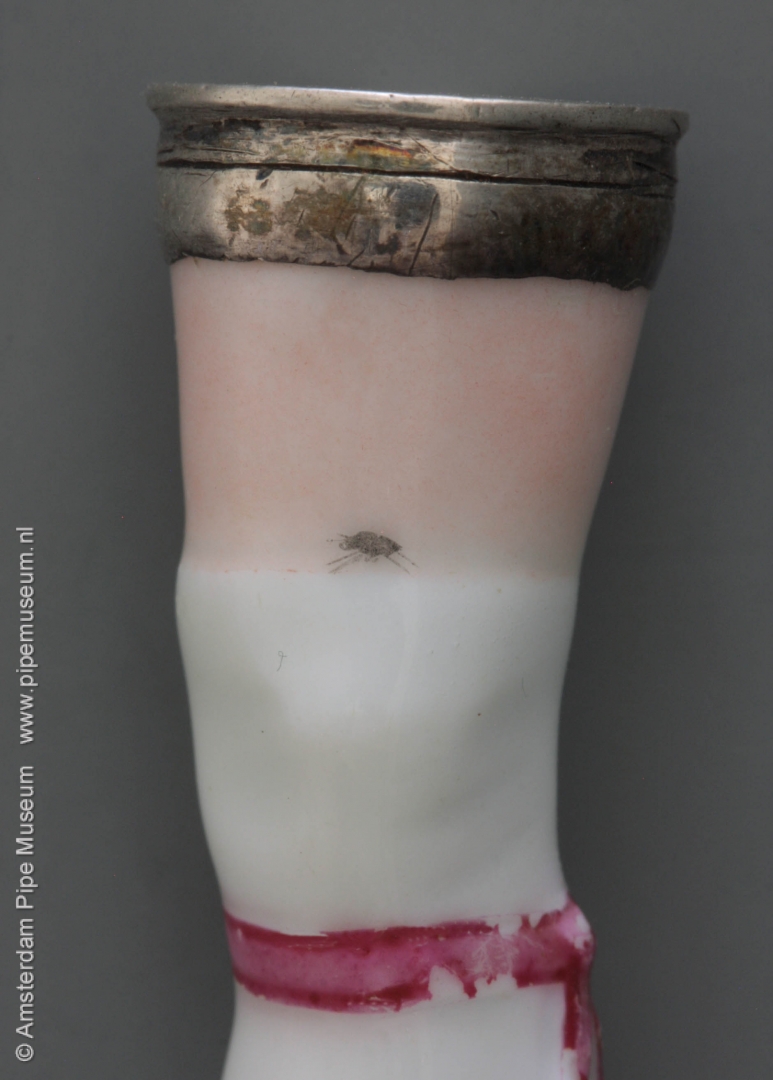
A nice detail is that even the embroidery on the stocking is painted, including the purple garter with bow that kept the stocking in place. By way of joke, a flea is sometimes painted on the leg, which can be seen here just on the separation of the stocking and the underpants. A spicy detail the owner could point out to his friends for entertainment.
That such stoppers were exclusive gadgets is also proven by the silver mounting. To protect the porcelain against sooty traces, a silver cap at the top makes it easy to keep clean. Based on the use of colour in the painting, we can date this stopper between 1770 and 1780.
The porcelain pipe stopper in the shape of a woman's leg stays in production during the nineteenth century. Such stoppers no longer originate from the best porcelain factories, but rather from Bohemian companies. These cheaper versions especially enjoyed popularity among students. For them the joke with the flea is more appropriate than under gentlemen of class. The later copies are easy to distinguish from the early ones. The size of the pipe bowl increases considerably after 1800, which makes the pipe stopper bigger and heavier accordingly.
Amsterdam Pipe Museum APM 18.452
Helmet as a spark-catcher
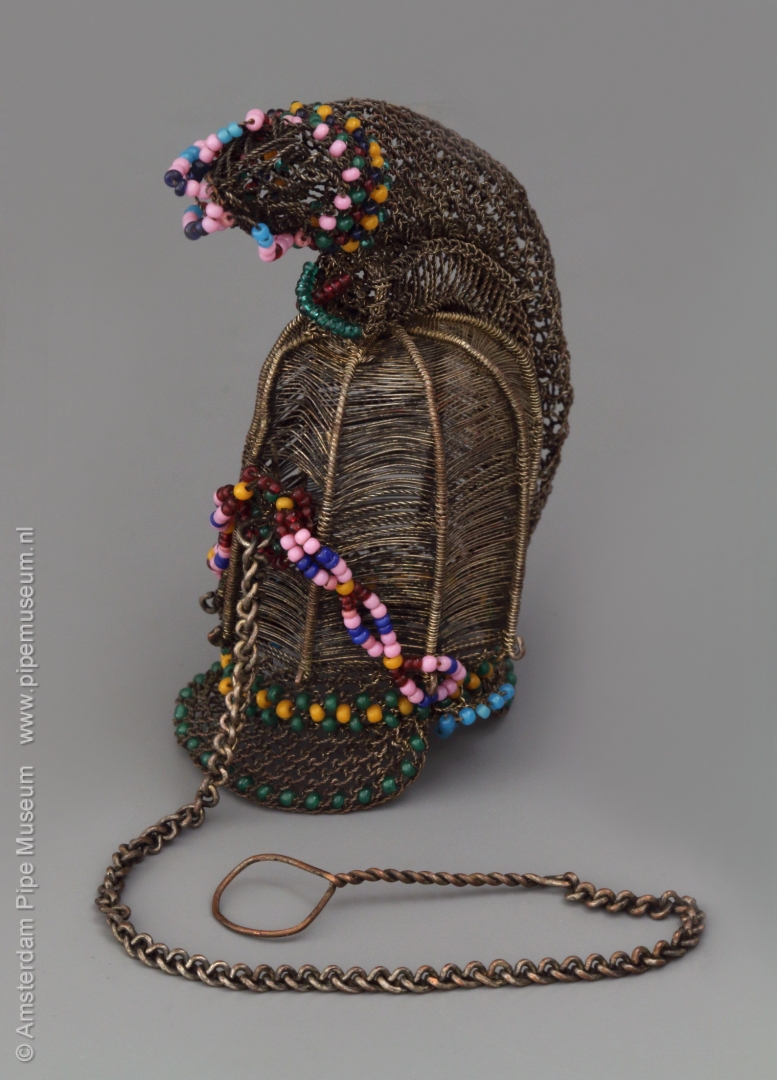
The spark arrester or spark-catcher is one of those wondrous objects that used to be commonplace, but that no one knows today. In the seventeenth and eighteenth centuries it was mandatory in some cities to cover the pipe bowl with a cap, as a fire risk prevention. Caps came into use made of thin metal wire braided in various shapes to cover the pipe bowl. It is said that the simplest ones came about as work in prison. In addition, there were also professional pipe-cap braiders active, next to the home industry.
The pipe cap shown here is a fine example of an extra luxurious item. The object has all the standard features with a fixed base under a more open dome shape, this has then been expanded with a double comb to make it an officer's helmet. The flap and small rosette on the side finish it off. As usual, the spark-catcher has a retaining chain with an eyelet to slide around the stem of the pipe. If the cap falls off the pipe bowl or if you want to light your pipe again, the retaining chain protects it from loss. Plus, you don't have to bend over to pick it up. While brass wire is normally used, this cap is made of fine silver wire that has been given glass beads as decoration during braiding. It is precisely this luxurious addition that gives the object a bright appearance and transforms it into a trinket or gift item.
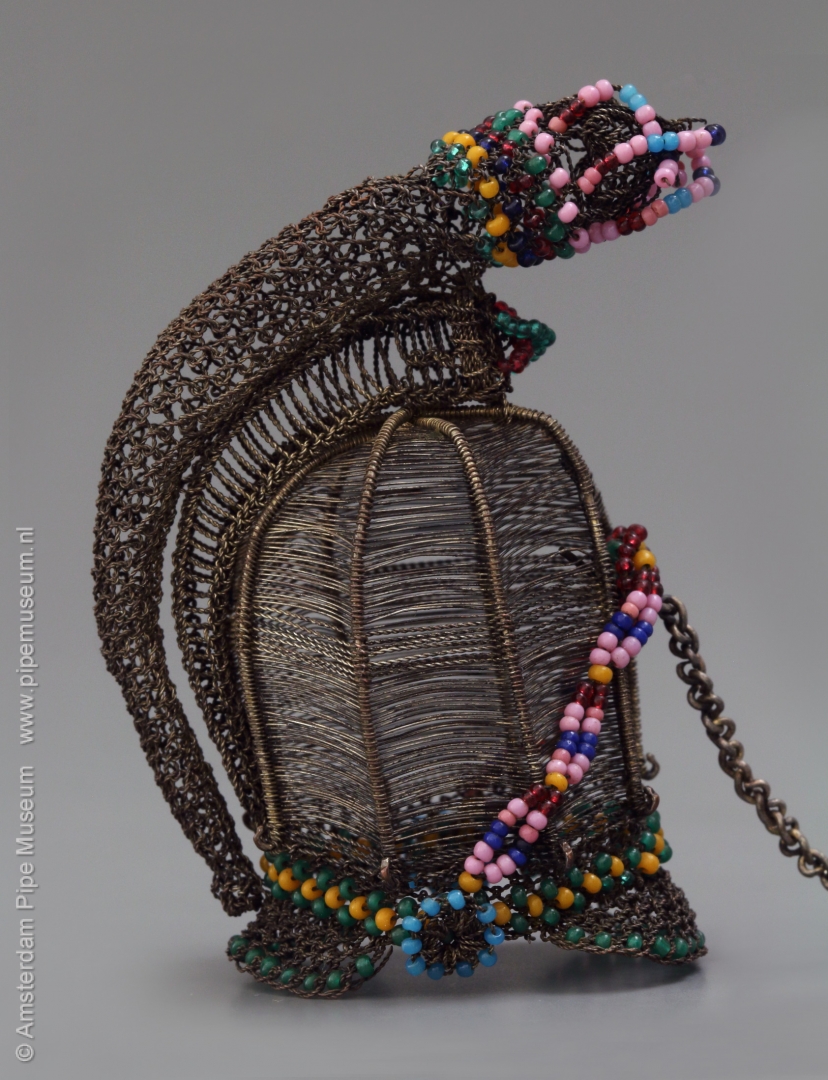
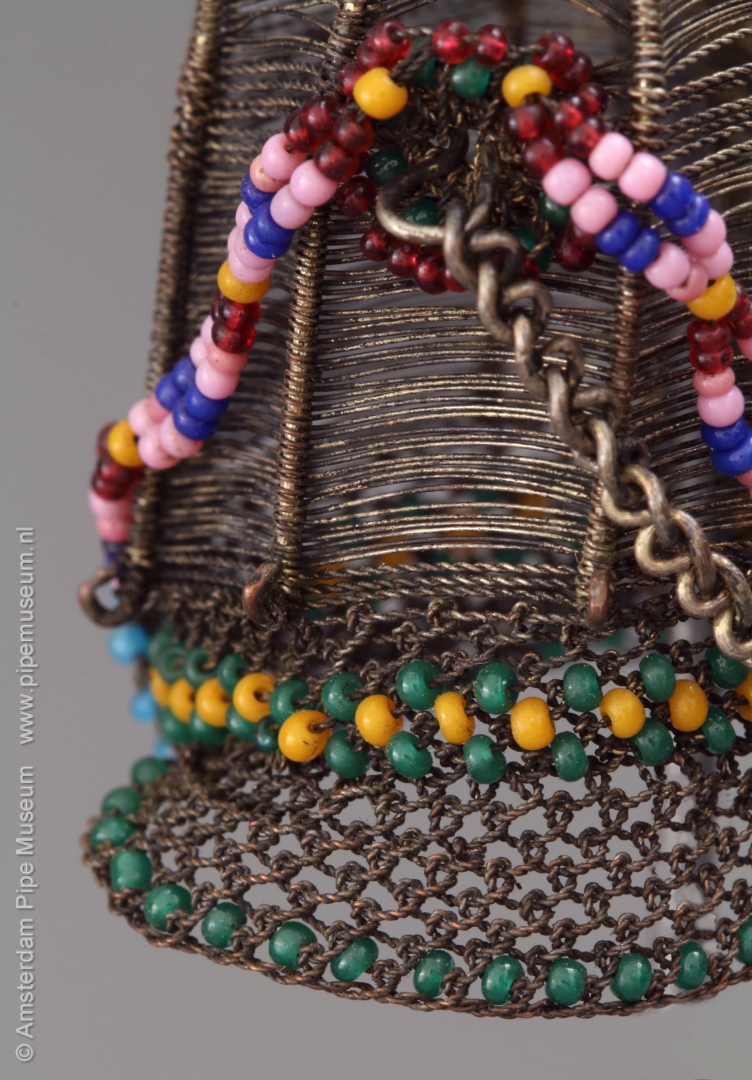
If we look at the wickerwork, we see that it has a admirable regularity. The dome consists of horizontal wires, alternately single and coiled, which have a thin rib at an appropriate distance that secures them to the previous loop, maintaining the fragile top in shape. Seven such ribs run across the dome. For the additions, visor, comb and another brim in the neck, silver thread was used that was first wound by twisting two threads together. Subsequently, a kind of knitting was made of this double thread, so that the end result is closer and firmer. The beads have been incorporated into the knitting here. All in all an incredibly meticulous work that undoubtedly took countless hours.
Interesting is an 1828 article in the magazine Penelopee, with the subtitle Monthly Work devoted to the female sex. It explains how ladies could braid the most beautiful pipe caps as a pastime, including an image of some examples. That monthly magazine focused on the well-to-do that kept themselves busy with innocent, but also useful pastimes. Braiding pipe caps intended as a present to a loved one or a dear family member was one of their activities.
We still can question whether it was really women's hands that made this object, or whether it is an industrial product after all. I am very positive about the latter, based on some specific characteristics. First, the silver wire is too routinely braided and too firm in nature to have been made by a dilettante. The silver chain is also too regular to be made by hand, although you could still assume that a standard chain with a self-turned eye was used here. After all, I have seen pipe caps decorated with beads before. Over time, more and more copies have become known. We should therefore see these pipe caps as a serial item for the market, although this one is the only one of its kind so far.
Amsterdam Pipe Museum APM 23.136
Tobacco box with Abraham's sacrifice
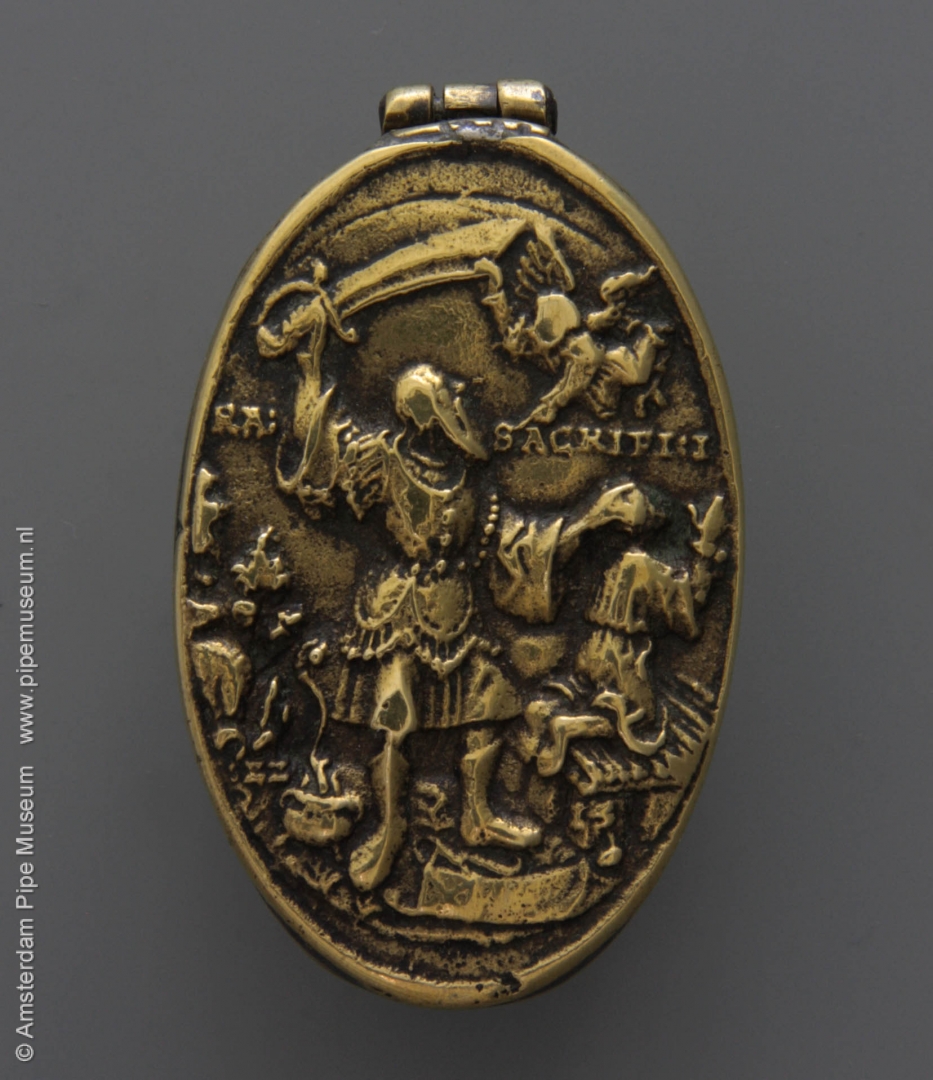
Extraordinarily intriguing are the earliest tobacco boxes, which date back to a time when not all smoking utensils were standardized. This box is a good example of this. Given its size and method of manufacture, it must date between 1625 and 1635. The box is made of brass in an oval shape with a flat bottom, straight sides and flat lid. This lid is cast with the sacrifice of Abraham in relief. To the left of the center is Abraham with his sword raised, a floating angel holds the tip of the sword, to the right on a sacrificial block is the kneeling Isaac, Abraham's hand rests on his head. At the top we see the text in abbreviation "RA:" for Rex Abraham followed by "SACRIFI: I", which stands for sacrifice with the letter I as an abbreviation of Isaac. At the feet of Abraham we see on the left a smoking tripod with the letters "ZZ" and under the offering block the letters "IS". It seems that these letters refer to the maker, a still unknown person with the initials "Z.Z." who must have worked in Iserlohn. In the 17th century, Iserlohn was the most important industrial town in Westphalia, famous for the manufacture of metal goods. Besides the needles, their most exported product, all kinds of die-cut and cast brass objects were in the making, including boxes.
The lid is decorated in high relief, the raised edge of the box is made in a different technique. The sides are printed with a lighter embossed decoration that unfortunately has worn quite severely due to frequent use or polishing. Yet we recognize lush foliage with, somewhat unexpectedly, a slender squid and twice the head of a dolphin. At least, as it was depicted in the seventeenth century with a convex forehead with the eye, button nose and dangerous mouth with teeth. In between we see a phoenix, a bird and other animals. On the inside, the box shows a single-sided hinge on which a cast conical brass pipe stopper is attached. Such pipe stoppers were indispensable in that period, as the pipe bowls were too small to press the tobacco with your finger. Such a stopper was therefore particularly practical.
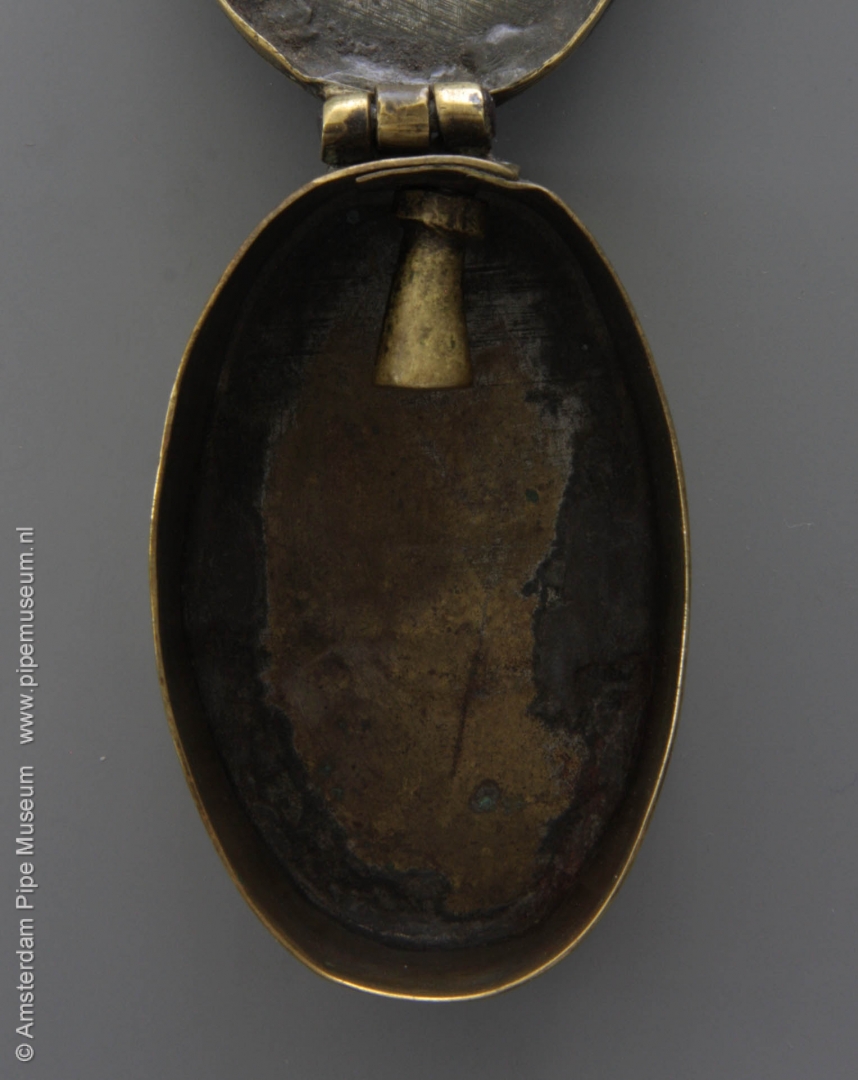
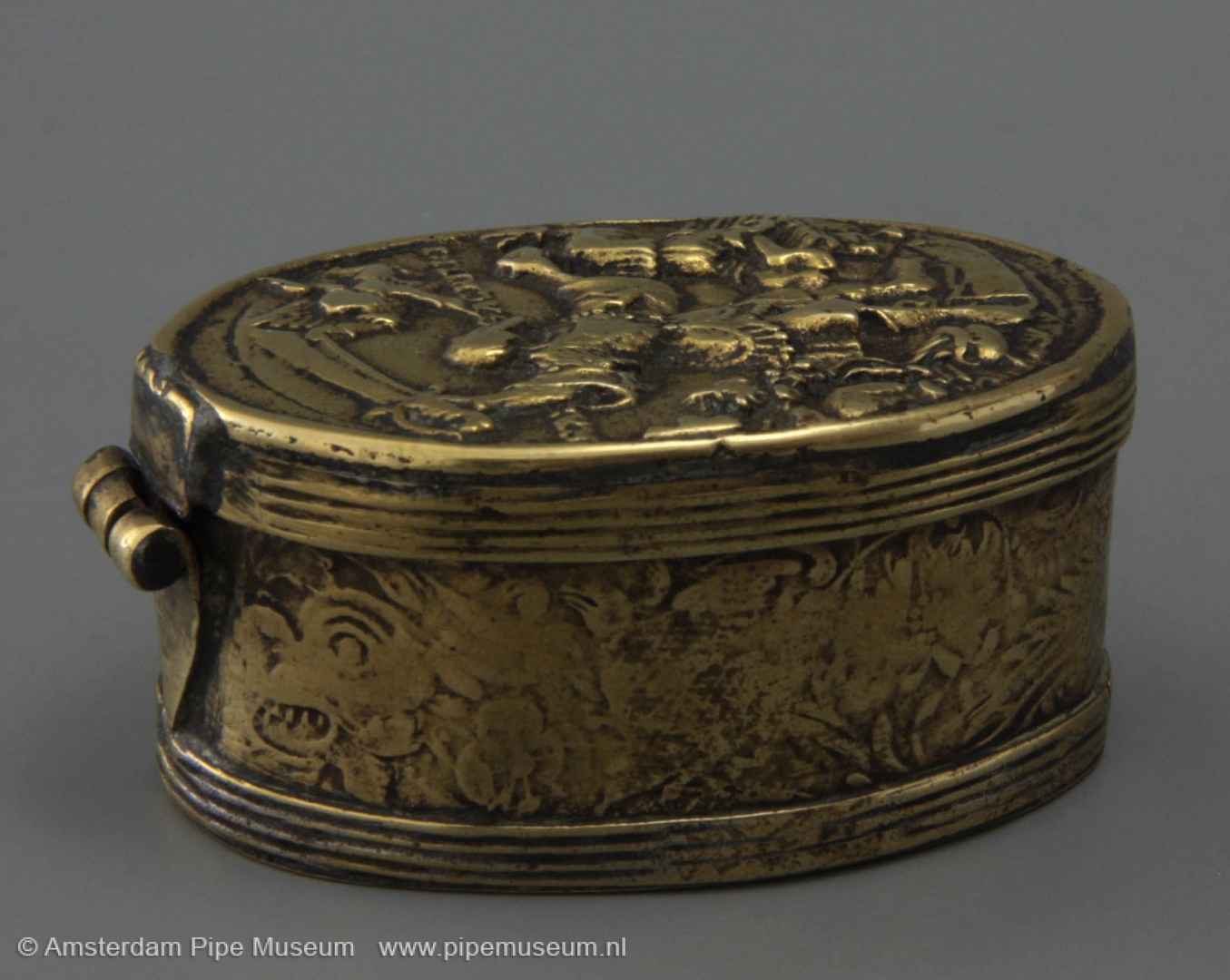
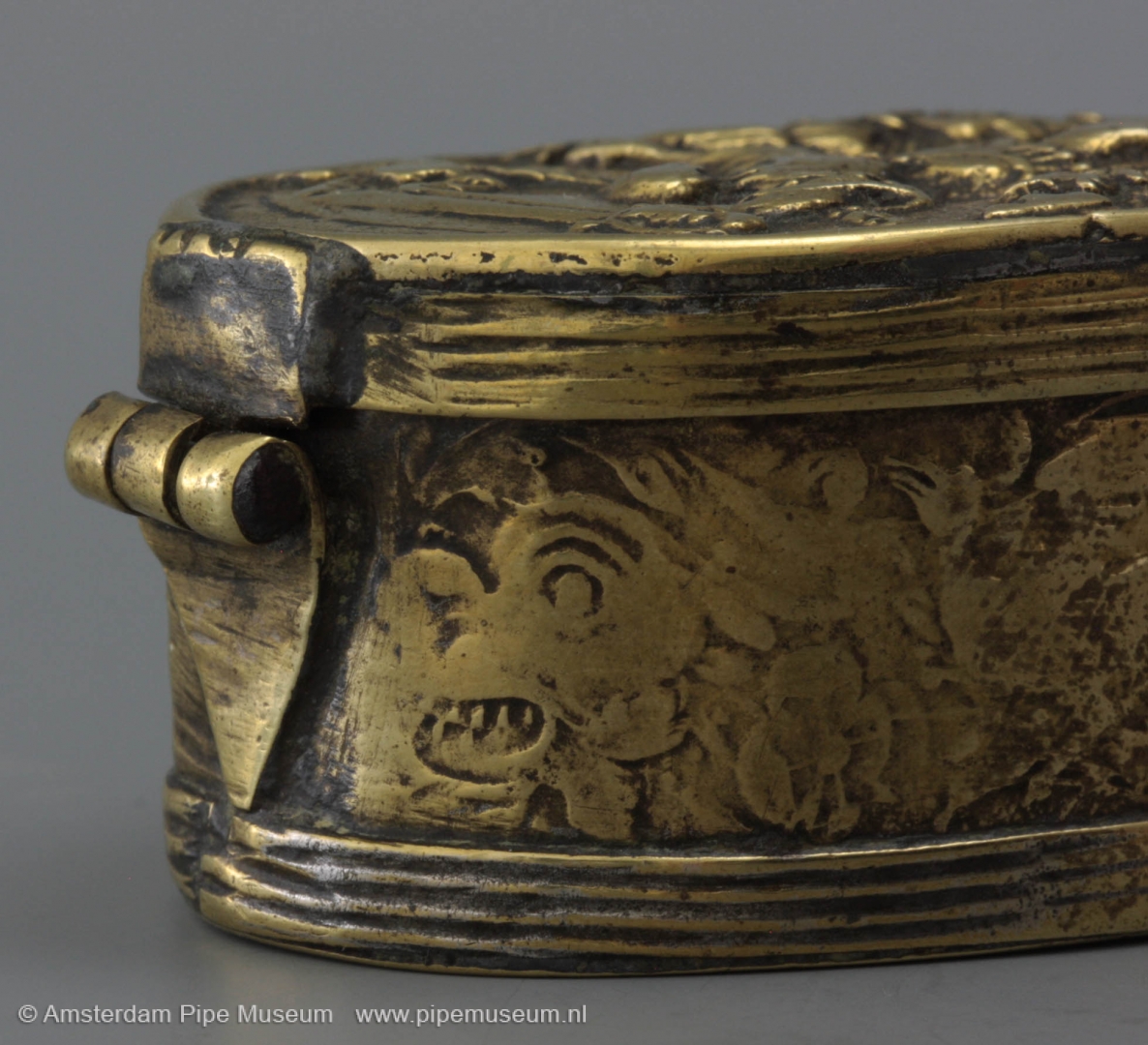
The origin of this tobacco box is also interesting. It was found in or shortly before 1986 as a detector find on the walls of the fortified town of Bourtange and must therefore have belonged to one of the soldiers or perhaps officers who were stationed there on the redoubt in East Groningen. For the owner at the time, losing his beloved tobacco box will have been bad luck. The opposite of the moment of happiness the honest finder experienced when his detector beeped and he found a rare tobacco box in such good condition. That moment of happiness took place three and a half centuries later.
Amsterdam Pipe Museum APM 20.712
Tobacco box with tortoiseshell
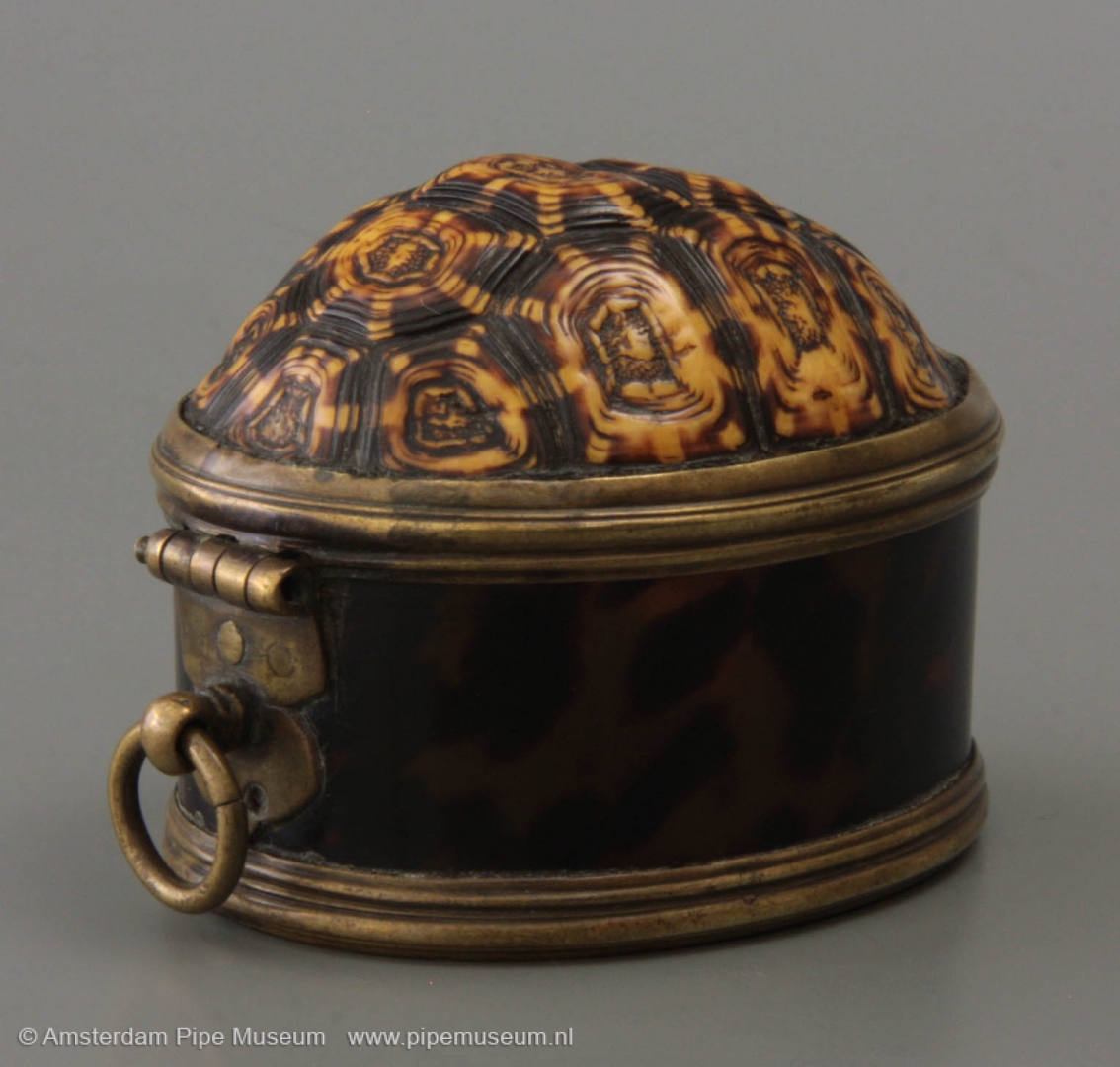
In the seventeenth century, the desire to show off grew among the Dutch citizen. In addition to articles made of gold and silver, special, preferably exotic materials were also eligible. Worldwide maritime trade yielded many such items, often obtained through barter. In the sixteenth century these objects were mainly offered to monarchs, in the seventeenth century they found their way to wealthy merchants in Holland. One of those special and therefore beloved materials is tortoise shell that was used in luxury objects. Covering boxes, veneering small pieces of furniture, but also processing it in an alternative way. This early tobacco box is a good example, especially since the use of turtle is shown in two ways. The lid of this sympathetic box consists of a complete back shell of a water turtle, inlcuding the ribs and vertebrae as we can see at the back, mounted in brass. The lid has retained the shape of the beast's convex shield, whose drawing in a pattern of octagons was admired as a piece of jewelry.
Interestingly enough, the box itself is also made of tortoise shell, but of tortoise shell plate only that, with a considerable thickness, gives the object optimal strength. Here too, a brass frame keeps the parts together. Box and lid are connected at the end with a two-pronged hinge. This hinge has a cam with a ring on the outside to carry the box on the belt. In that case the flat bottom hangs against the body while the shield is displayed to show off. The small box reflects the high price of tobacco in that period. To facilitate stopping the small pipe bowls, a conical brass pipe stopper was internally mounted. Such stoppers prove that it definitively concerns tobacco boxes.
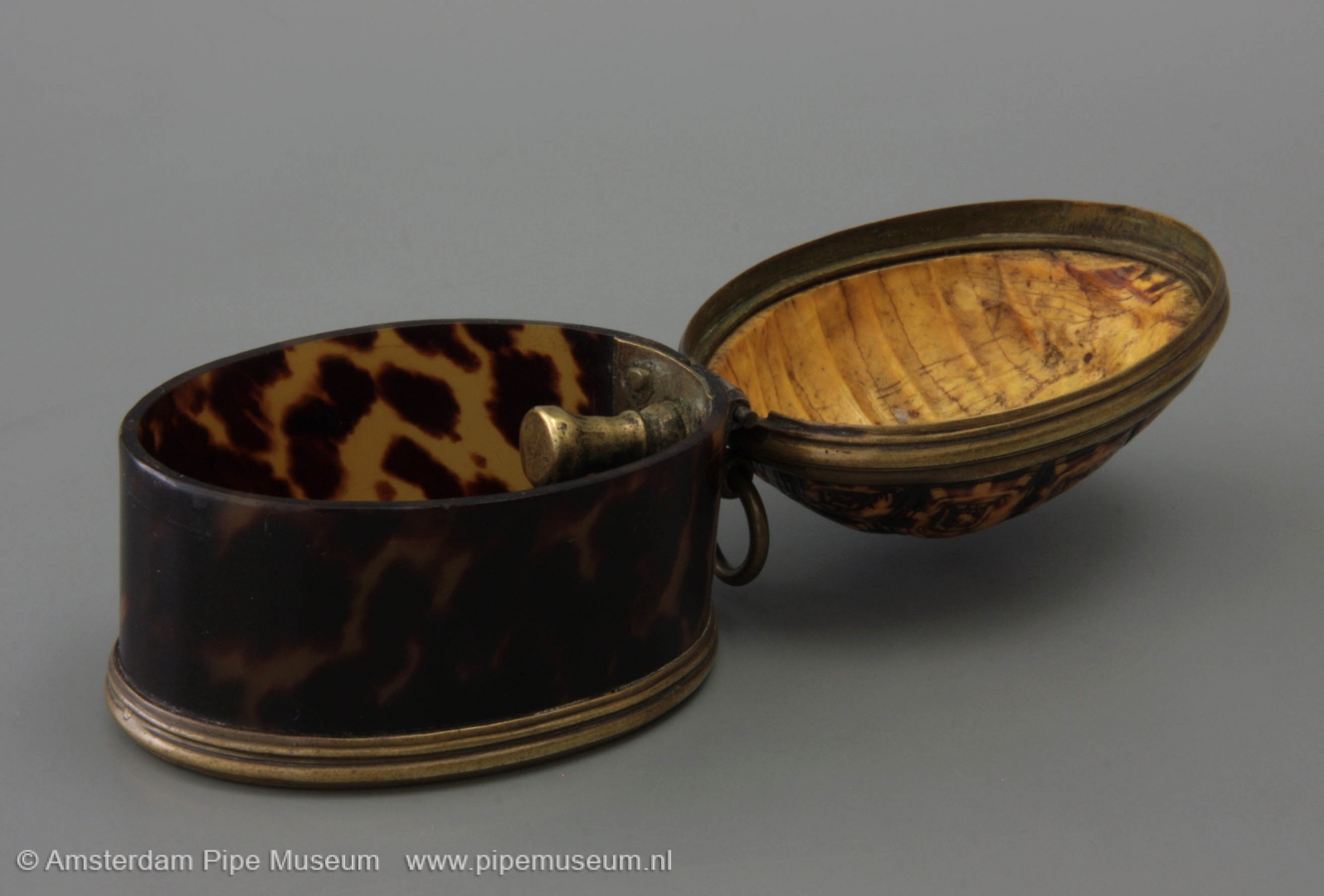
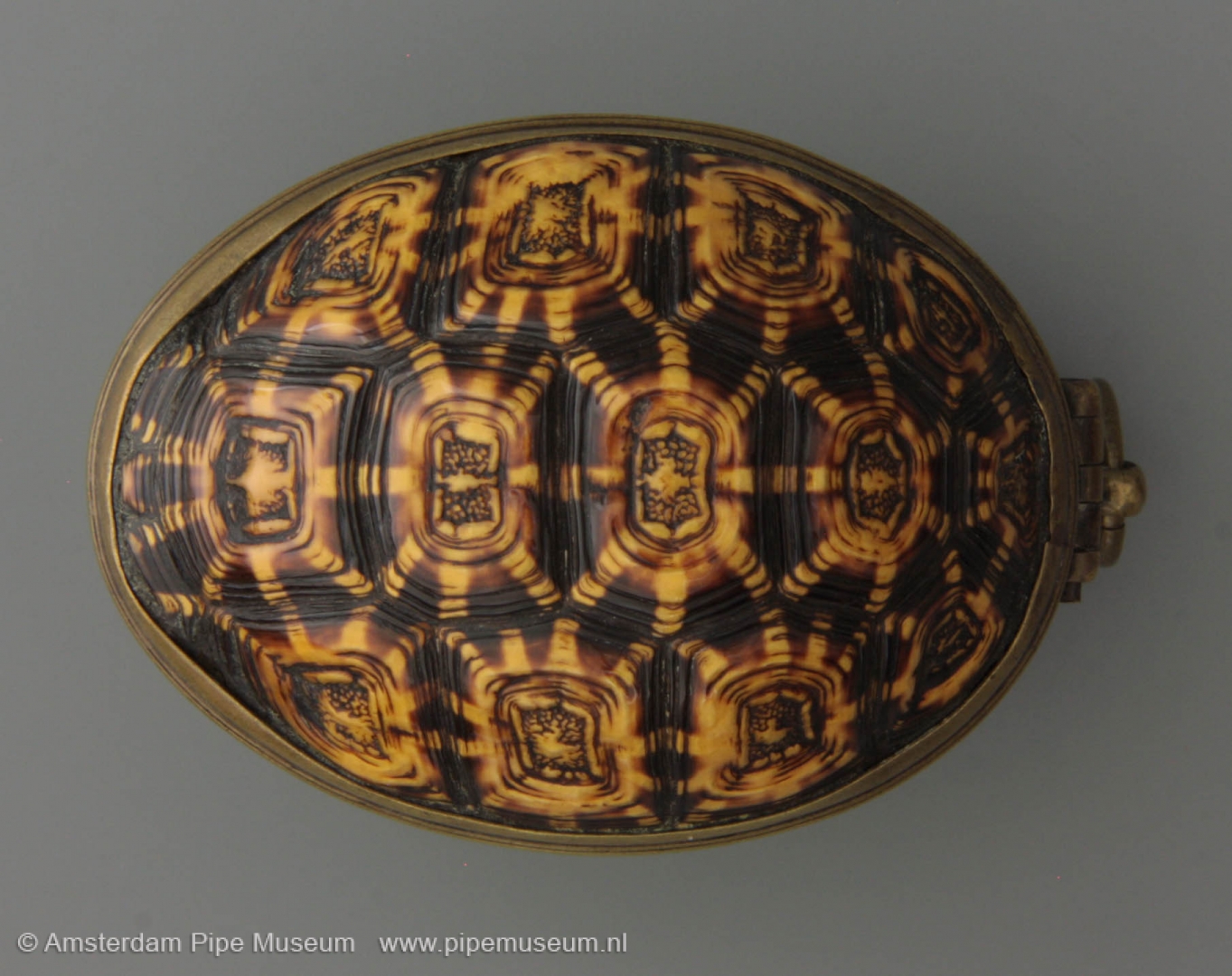
No matter how beautiful in simplicity and materials, it is not about a one-off. Such boxes have been so fashionable for a period that they were made in series. When we compare the boxes, we see similarities or differences in size or shape. We also see a distinction in the mould that was used for casting the pipe stopper on the inside. Despite their luxury, they were utensils that gradually deteriorated or fractured through an accident. It is therefore not surprising that there are very few such fragile tobacco boxes left today.
Amsterdam Pipe Museum APM 20.324
Tobacco box with sliders
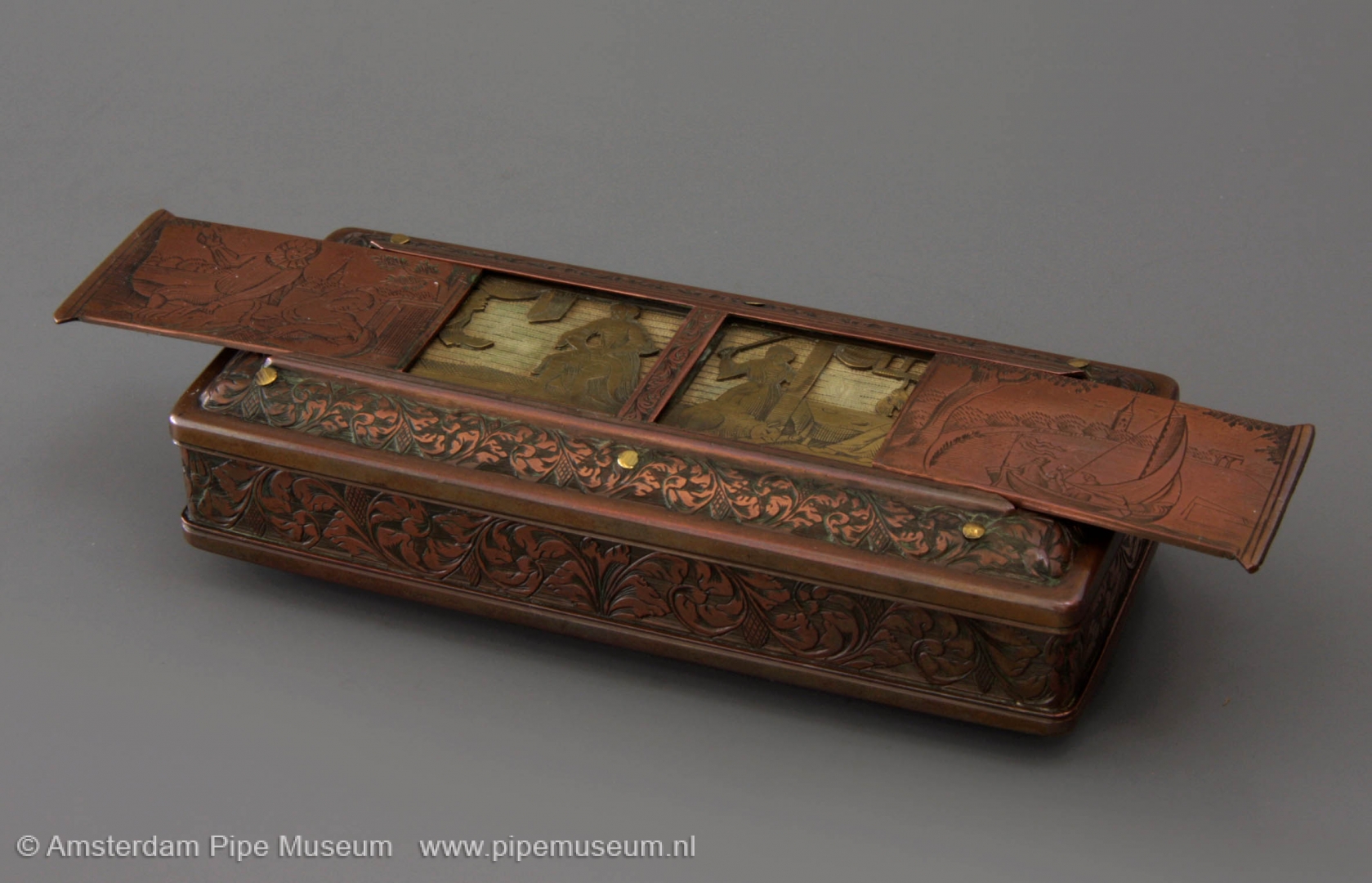
The Dutch pocket tobacco box was used by smokers throughout the eighteenth century to store and transport tobacco. In that century, the tobacco box changed from oval to rectangular, to get rounded ends or chamfered corners later on. This box has the simplest model, it is rectangular in shape with straight upright sides. The top and bottom edges are rounded to allow the box to slide easily into the pocket. With that shape, the box fits in the period between 1720 and 1750.
It is not the shape of this box that is special, but the design and finish. It is not about a simple box engraved on the outside and smooth on the inside, but here the maker has taken up the challenge to make something really worth seeing. The top and bottom are each provided with two rectangular engraved fields that prove to be slides hiding additional images. The box is also unexpected internally, where a decorated brass inner plate is mounted.
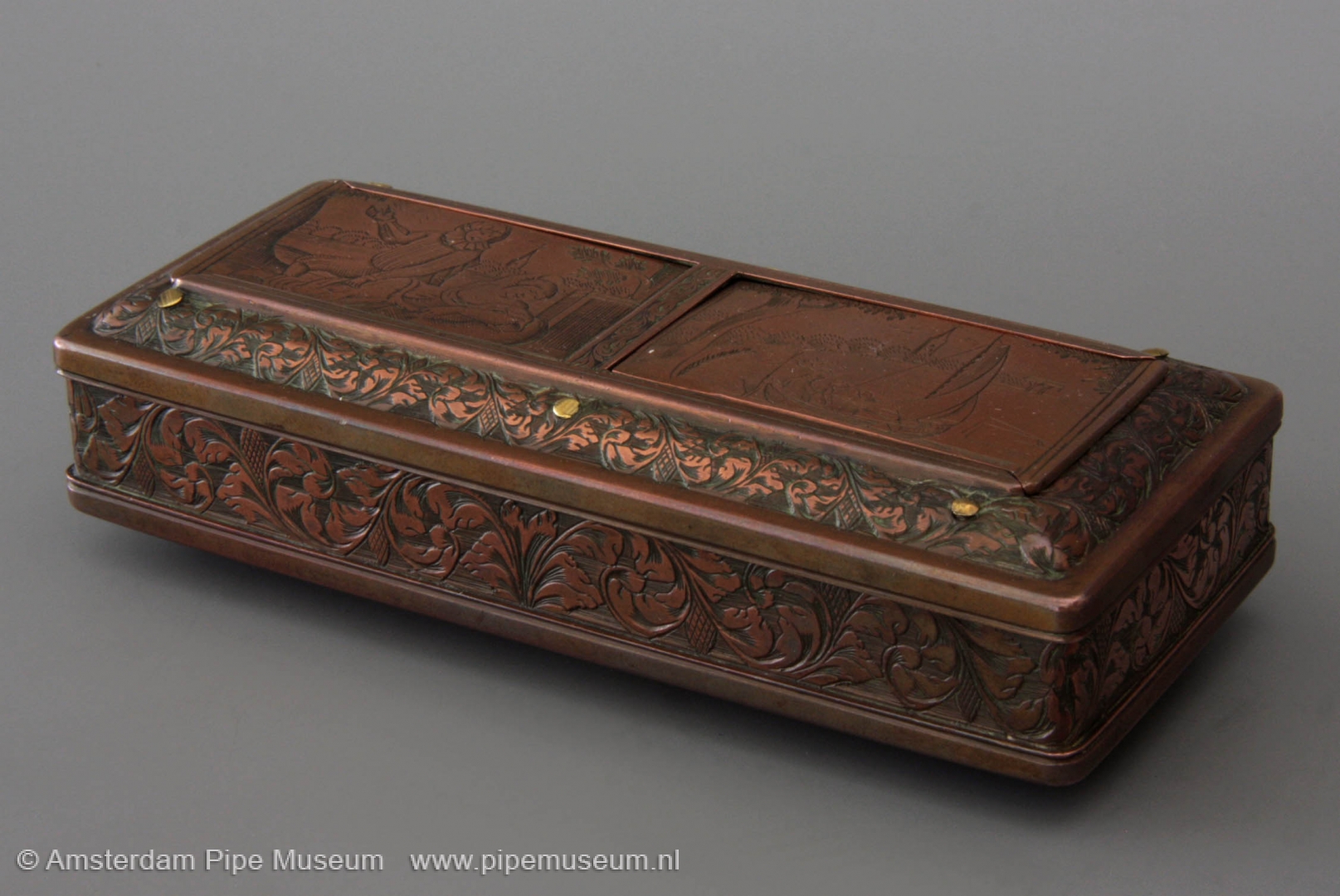
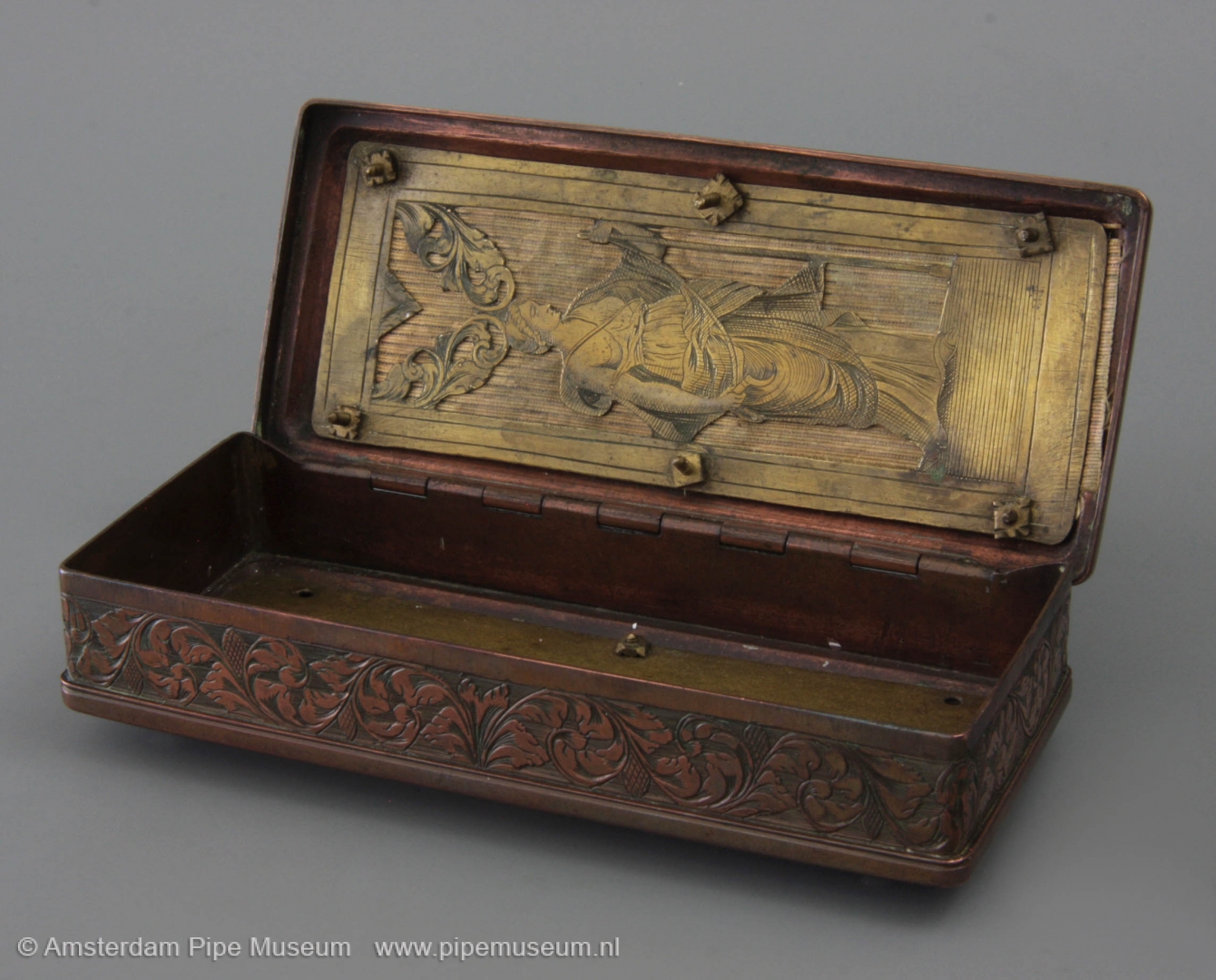
The lid and bottom show fairly innocent scenes on the outside. We see, for example, a clown-like man with a woman, or a sailing boat on a lake, also gallant scenes of figures in a landscape. When it appears that you can open the sliders, images of a different order will appear. Then the eroticism drips off. For example, in a room we see a woman pointing at her crotch with her skirts lifted, looking at the man in front of her, or a woman at a table holding up a dead chicken, a second woman lifting a stick to hit a cat that chews a giant phallus. The bottom shows twice a dancing naked Fortuna and a table with men playing dice. In short, scenes pass behind the sliders that cannot tolerate daylight.
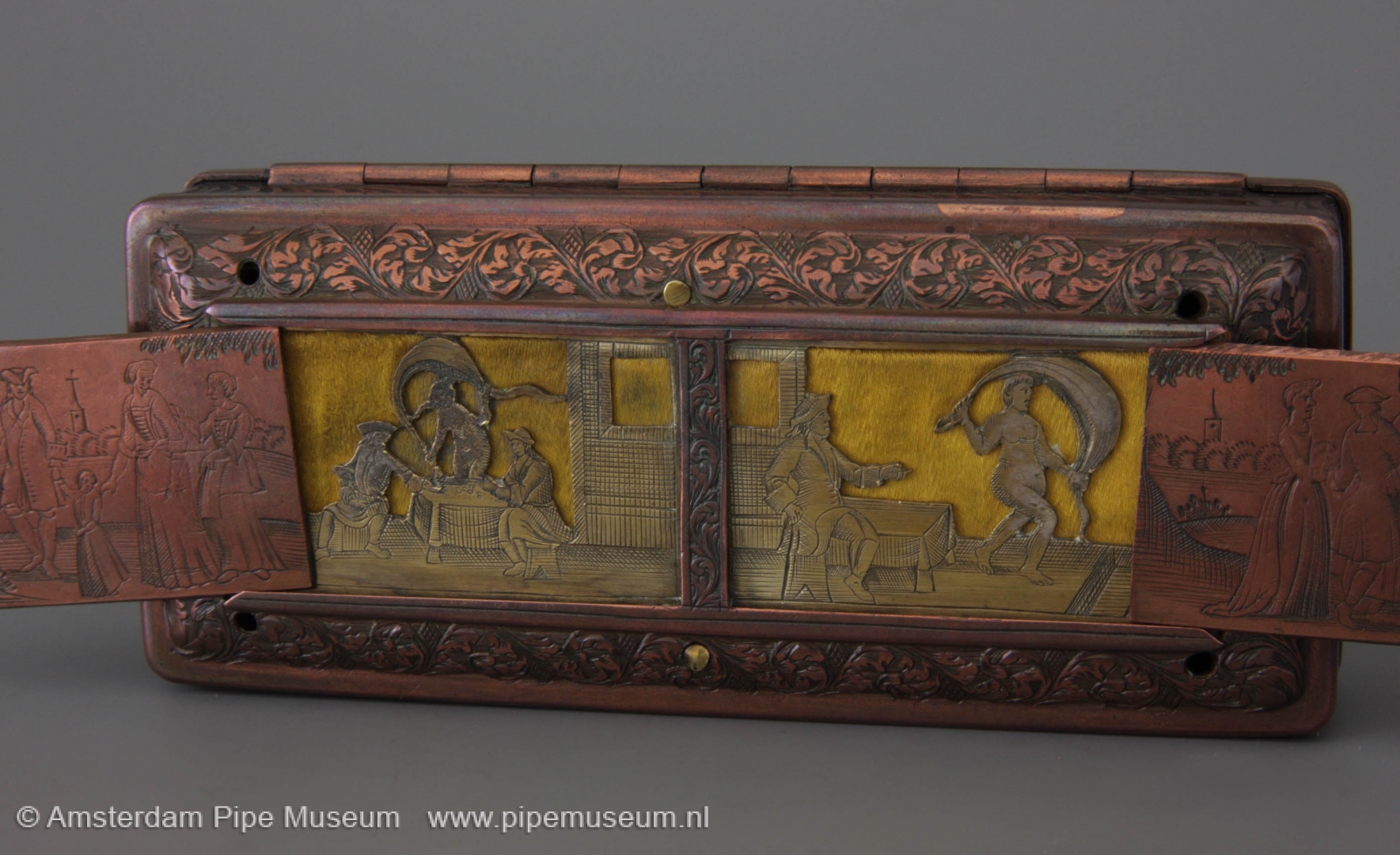
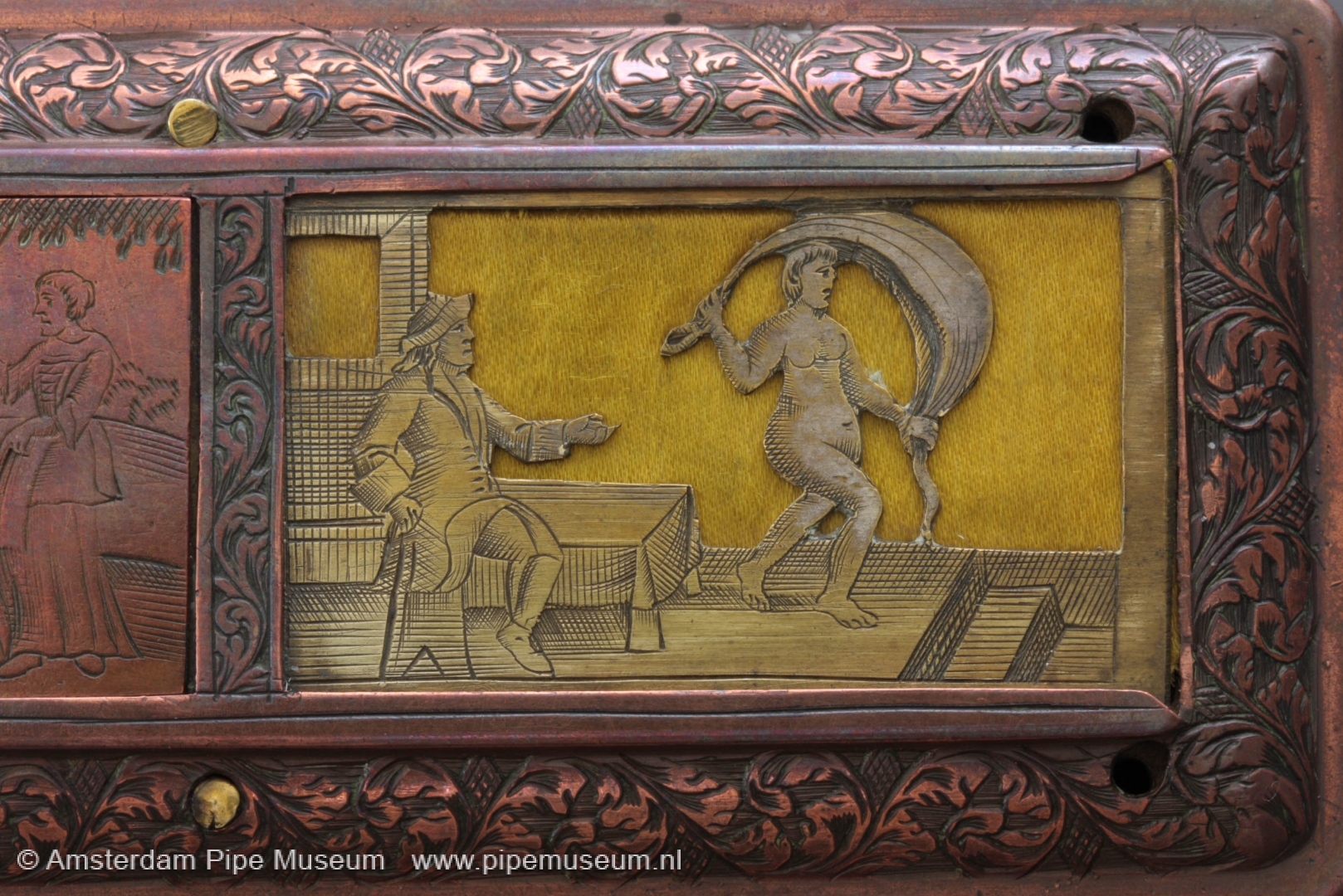
As a whole, the box is a fine piece of craftsmanship in two colors of metal: red copper and yellow brass. Note, for example, the deeply carved engraving of a meandering leaf tendril that runs around the rounded edges around the bottom and lid. But even behind the sliders the artwork is done with care. In the erotic scenes, the copper plate is even partially sawn out and placed against yellowish cloth. Moreover, these images are silver-plated so that in the past they were shiny to the eye of the beholder. In addition to the eight scenes, there is the sawing and engraving work in the inner cover, the theme of which, incidentally, is only moderately linked to the erotic intention of the outside. There we see a standing woman in Roman pleated robes with staff and sickle, recognizable as Ceres, the goddess of agriculture, because of her sickle. Pay particular attention to the shaped scew-nuts that hold the inner cover.
Although the maker has delivered a true work of art, which he spent hours tinkering with, it is not unique. Every craft object is remade at some point, especially when the maker enjoys his work and the sale has been successful. This also applies to this type of boxes. One in a few hundred comes in this unexpected doubled version. In addition to this type with four sliders, there is a variant with two longer sliders, which is slightly easier to make. The fact that these luxury goods are relatively more often preserved is due to the show-off function. It's not so much a box for everyday use, but rather something to flaunt every now and then. In the end, a simple box was more comfortable in the pocket and easier to use, because it was smoother and significantly lighter.
Amsterdam Pipe Museum APM 20.725
Table tobacco jar with tobacco merchant
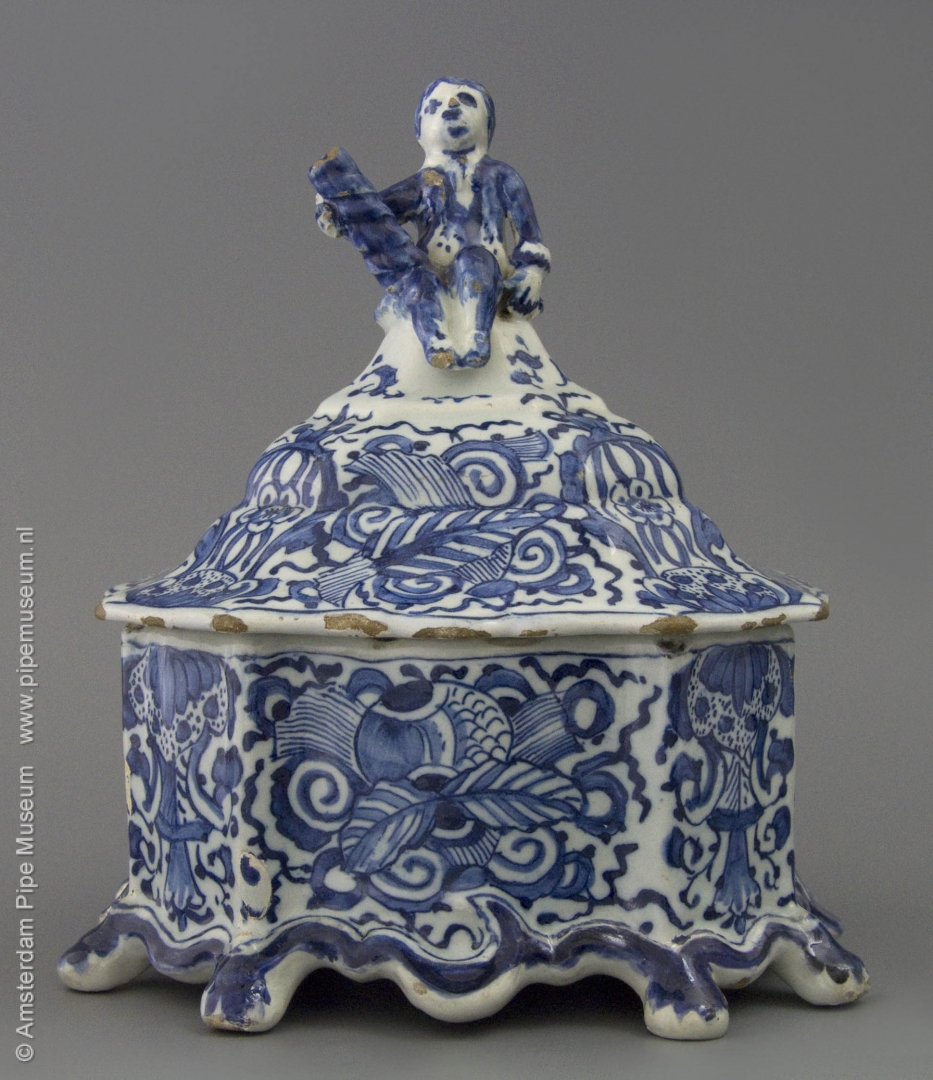
Making a tobacco jar in Delft Blue earthenware has been a tradition for ages. They were bought by well-to-do citizens who could not afford a silver tobacco jar like the very rich. Although they were primarily consumer items, many pots eventually ended up in a display cabinet. Thanks to that, numerous have been preserved. It is interesting that in the table tobacco jar you can closely follow the change of styles, in silver, Delft earthenware and Chinese porcelain alike. That makes it a real conversation piece for present art historians.
This table tobacco jar is a good example. The pot has a square shape and has eight protruding legs. The vertical walls have strongly chamfered corners, making the pot almost octagonal. To make it extra vivid to the eye, the walls wave in and out. It is a shape copied from silver tobacco pots, where this shape was easy to achieve by soldering walls to a base plate. It is certainly not easy for a potter to make unless, as happened here, he devised a printing mold for it that facilitates production. On the inside, this jar has a flat inner lid with a knob. That inner lid has been left pretty simple. Only three small leaves on the four corners are painted in blue. Such lids served to compress the tobacco so that it dried out less quickly and thus continued to taste better. The decorative lid to close the pot is domed and goes in a few curves to a small statue that functions as a knob. In this lid knob we see a seated Dutch tobacco merchant with, very appropriately, a tobacco roll in his right hand.
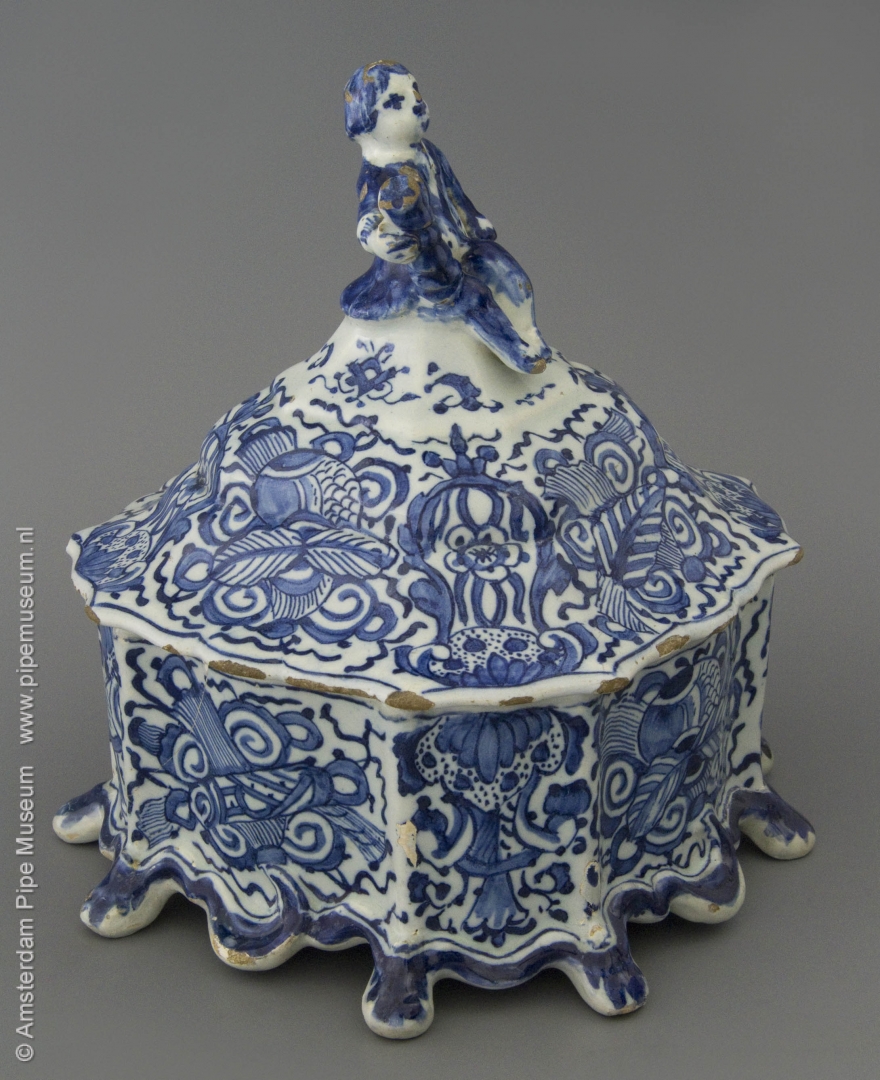
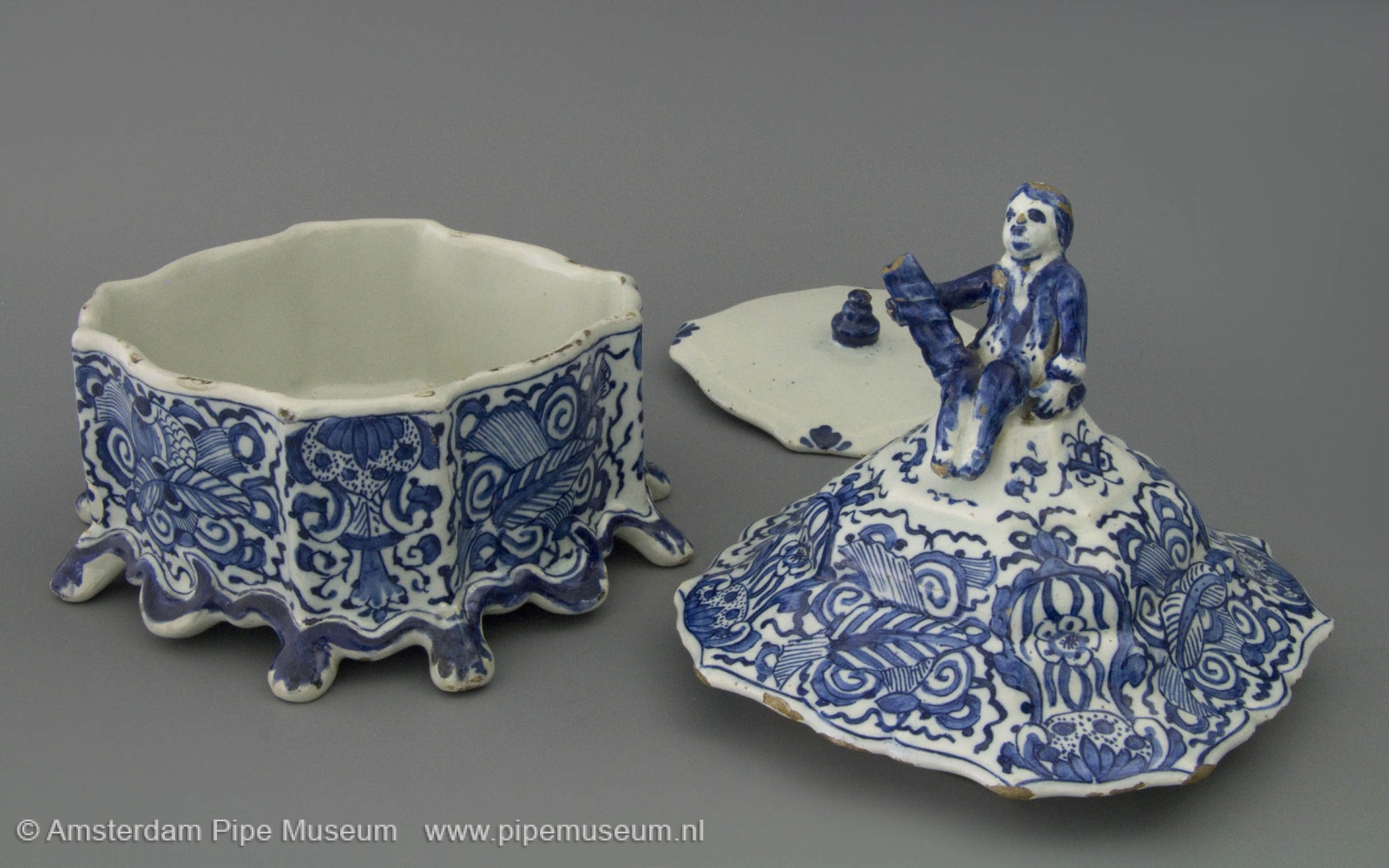
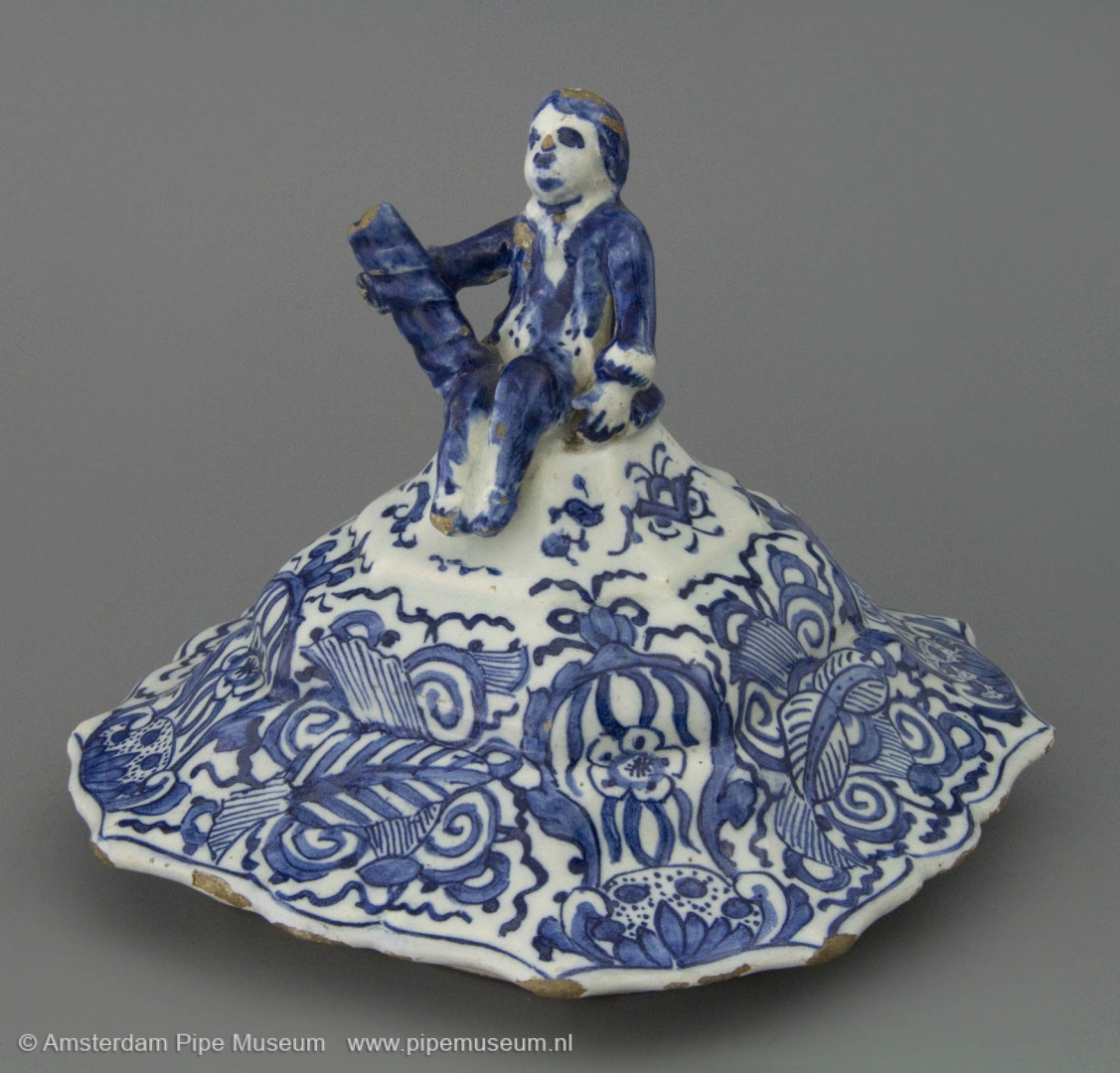
The pot and lid are painted all around in Delft blue, but show the Chinese Wan-Li style. Quite distinct the stylized artemisia leaf, which in this case we might prefer to refer to as a tobacco leaf, alternated with a large pomegranate and a scroll surrounded by ornamental work. This work is separated by a kind of Louis XIV fields. Some shapes of the silver example still have fashion features of the quinze style, such as the contoured edge along the bottom. The paintwork, on the other hand, harks back to the Chinese Wan-Li, as noted. Clearly, there is no style unity. The manufacturer has made an object to suit various tastes, although you wouldn't say that at first.
The Delft potter Johannes van Duijn is the maker. He produced more such tobacco jars. The decors change, as do the lid knobs. There is even a variant where the tobacco man has been exchanged for a female. The date is somewhere between 1760 and 1780. Van Duijn always had a few such pots in stock in his shop. Because the decors differed, the customer was able to make an appropriate choice. In Delft blue or in polychrome, fully painted like this one or with modest brush work. After the sale of the last copies, the object came into production again and the painting was based on the latest sales experiences. In this way of operating of the pottery company, we still can recognize the artisanal inspirations based on tradition combined with the clever business approach.
Amsterdam Pipe Museum APM 22.056
Double pipe case
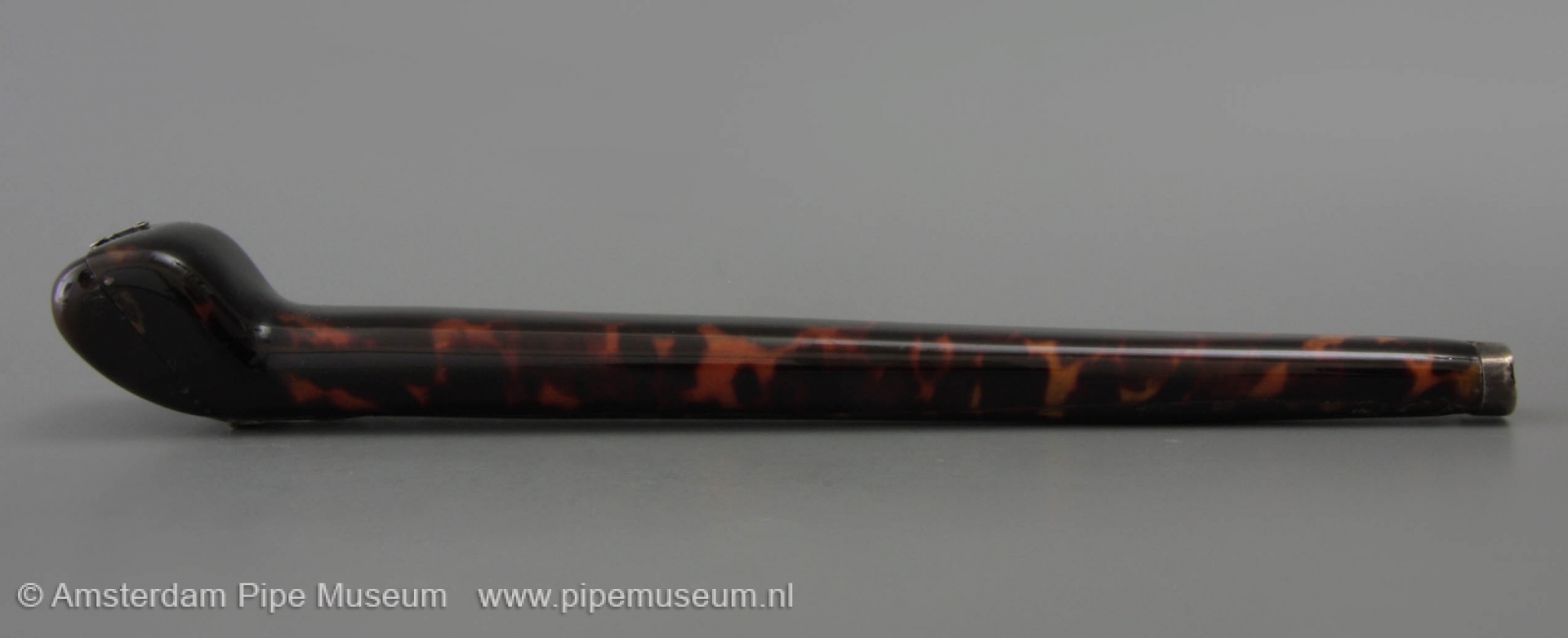
This pipe case or pipe holder looks quite simple and unadorned at first glance, but is of extraordinary rarity for several reasons. The elongated shape has a wooden core, covered with a thick tortoiseshell and fitted with a modest silver mounting. The conical end has a silver cap, the front flips open with a silver two-pronged hinge with pointed ends. This hinged lid is secured by a simple but elegant silver closing hook. The interior is lined with red velvet to protect the fragile contents. The beauty of this object is evident in the pure simplicity and the perfect way in which the tortoise is shaped and polished.
In this case, the rarity is not only in the exotic tortoiseshell, which can indeed be called exceptional, but even more in the size. The total length is no more than 24 centimeters, while everyone knows that a standard Gouda pipe measures almost fifty centimeters, unless it is a specimen from the early seventeenth century. Given the overall length and interior space, this pipe-case has long been regarded as an early seventeenth-century specimen, but on closer inspection, that idea is incorrect. The interior space is too large for first-generation clay pipes, assuming a case fits tightly around the object to prevent rattling and fracture. On the other hand, clay pipes from around 1630 do not fit in terms of stem thickness. The object must therefore originate from a different time. The conclusion is that this storage box is intended for exceptional Gouda clay pipes in miniature design, dating from around the year 1700. At that time so-called quarter-measure pipes were made, as the name says at a quarter the size of the standard tobacco pipe. Not only the length was reduced to scale, but the stem thickness as well! The refinement in finish such as polishing and milling the pipe bowl rim was not inferior to the highest quality Gouda products. These so-called case pipes, as a rare mention in the archives calls them, were an exclusivity of their time. For such refined, but above all delicate products, it was logical to order an appropriate casing.
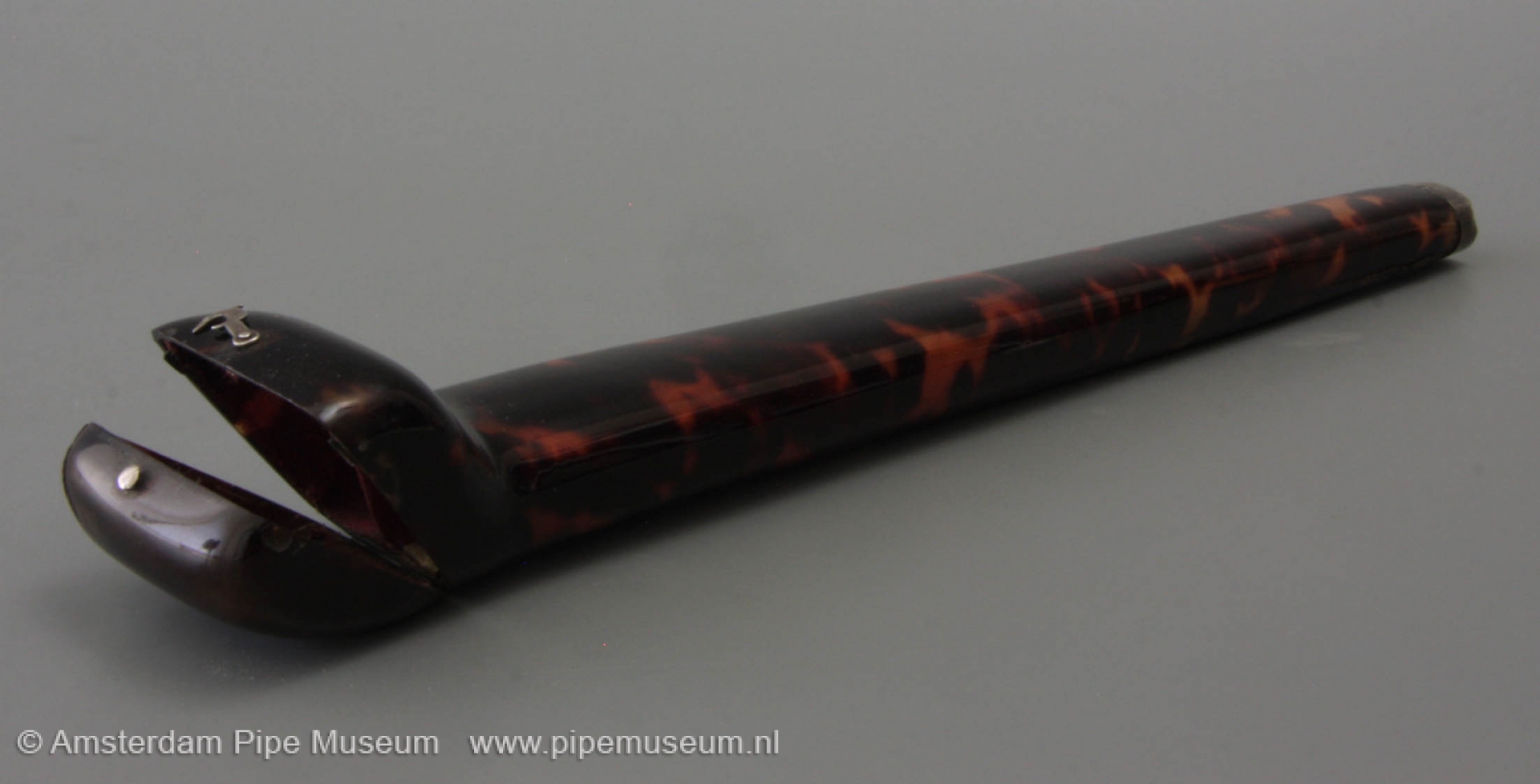

The phenomenon of a double pipe case has existed since the 1660s. From that moment on, crafstmen in what was then Ceylon carved wooden pipe cases, covered with ivory and intended for two standard Gouda clay pipes. The desire for a case for two clay pipes has been a tradition from that moment on and can be seen throughout the eighteenth century. It was used mainly in the Far East, sometimes even in colonies in Africa, rarely in Europe. Whether the double pipe case is a symbol for smoking together or merely practical for the owner to have two pipes available has never been explained. It is an interesting phenomenon. In the case of this tortoise pipe holder it seems that it was an object of great luxury, not so much for standard use as for display, but in a modest way recognizable only to the true connoisseur. Given the very modest bowl size of the pipes that fit in this holder, the aspect of smoking together is not really a hospitable gesture.
Amsterdam Pipe Museum APM 20.323
Carved pipe case
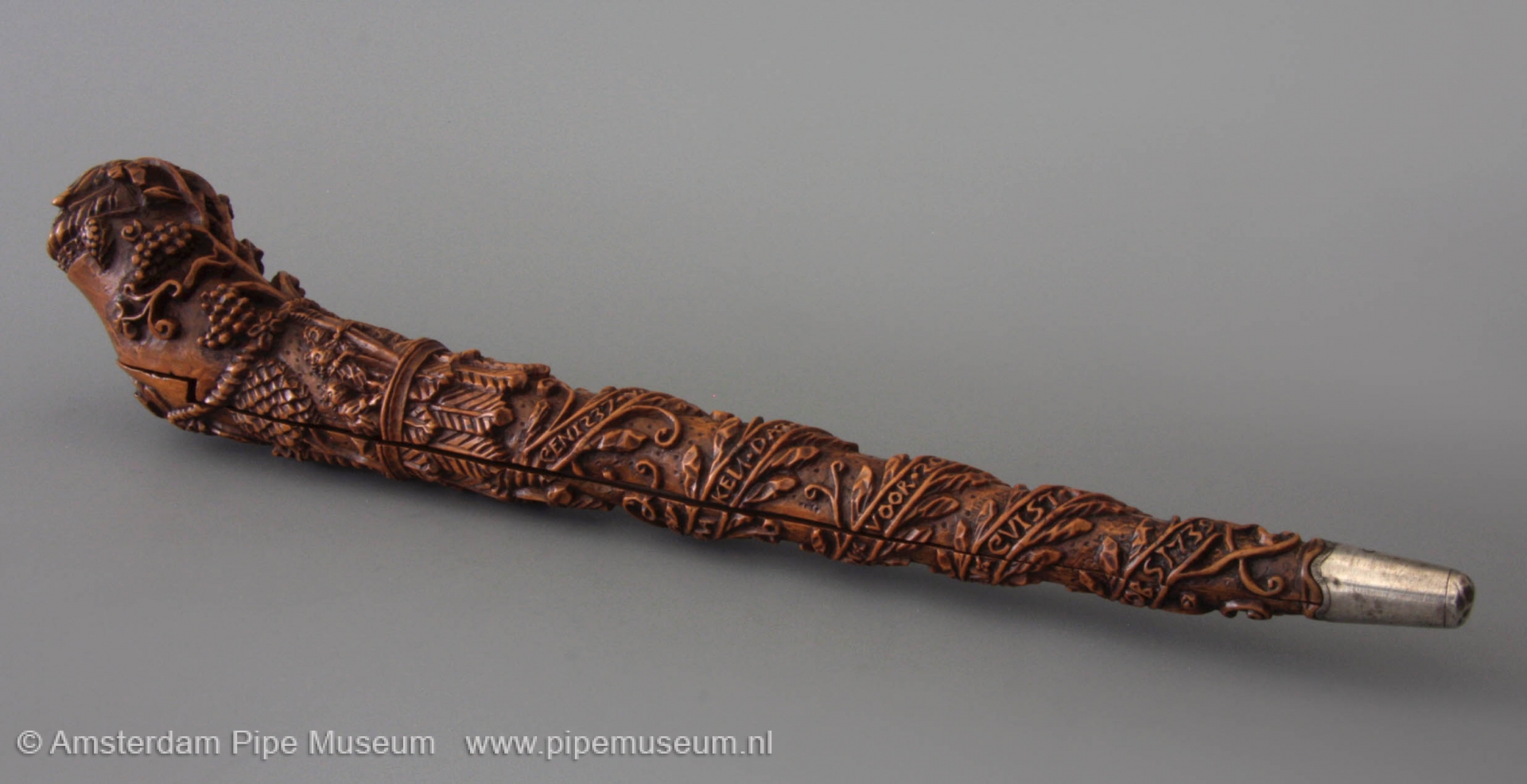
For the smoker who uses a clay pipe, storage without breaking is a great wish. It is not surprising that pipe cases have been in use since the seventeenth century. Stored away, the beloved well-smoked pipe can safely be carried. It is not surprising that the show and status function quickly played a role in such pipe cases or pipe boxes. Fine wood carvers discover the pipe case as a rewarding object for decoration. And the smoker, in turn, sees the pipe case as a status item, an object to impress. One such example is the pipe case to be discussed here.
The object is made of boxwood, a fine walnut that can be carved in detail due to the solid structure. This pipe case shows how appropriate the material is: despite the substantial relief, not a single piece has broken off in almost 300 years! Its shape describes the clay pipe with an oval bowl part and a straight tapered stem. A slide at the bottom provides access for the clay pipe. The object is completely overgrown with carved images and even text, something we don't see very often. At the top of the bowl part we see a tulip motif, on the stem side a grapevine. A twisted ribbon with extensive inscription has been carved around the stem. This text ribbon is edged with simple foliage.
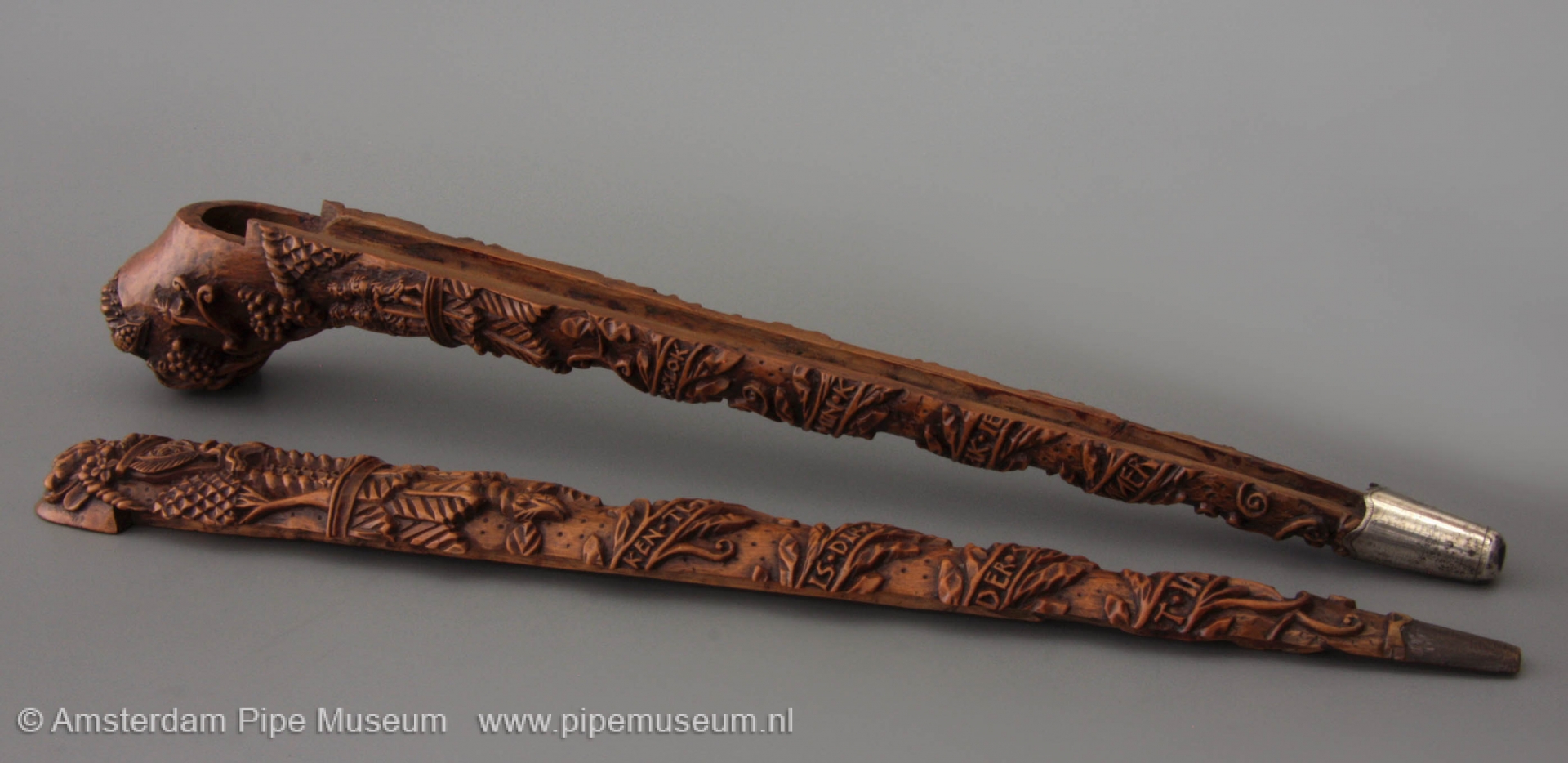
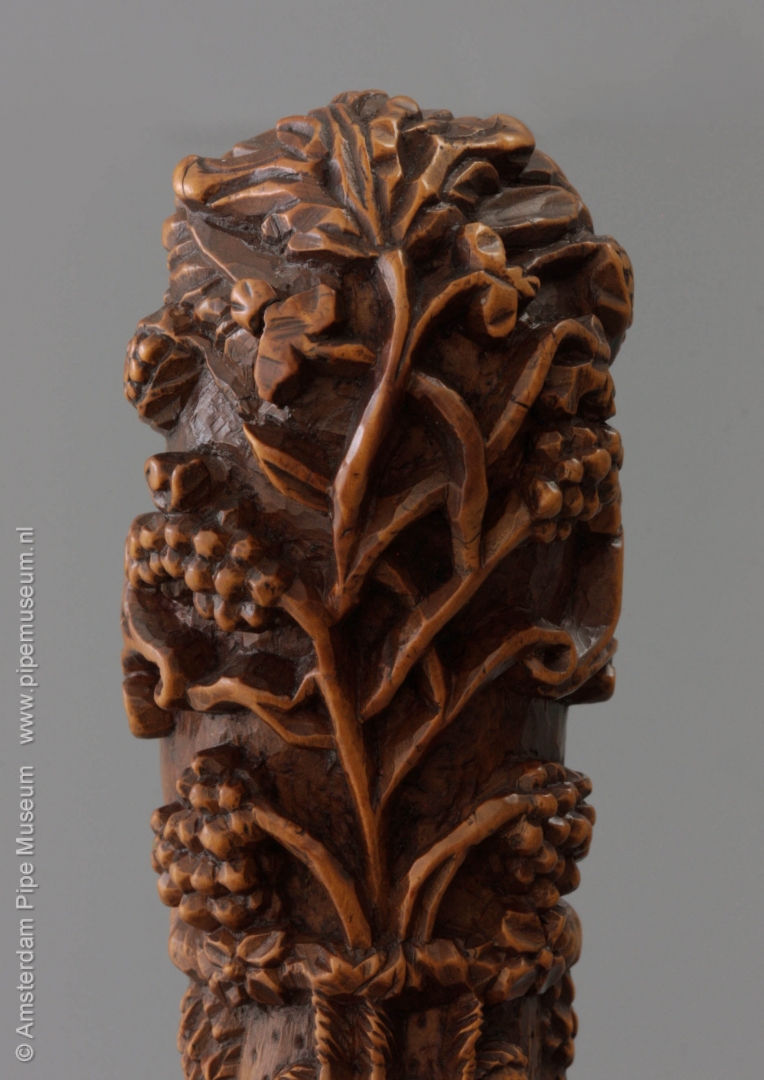
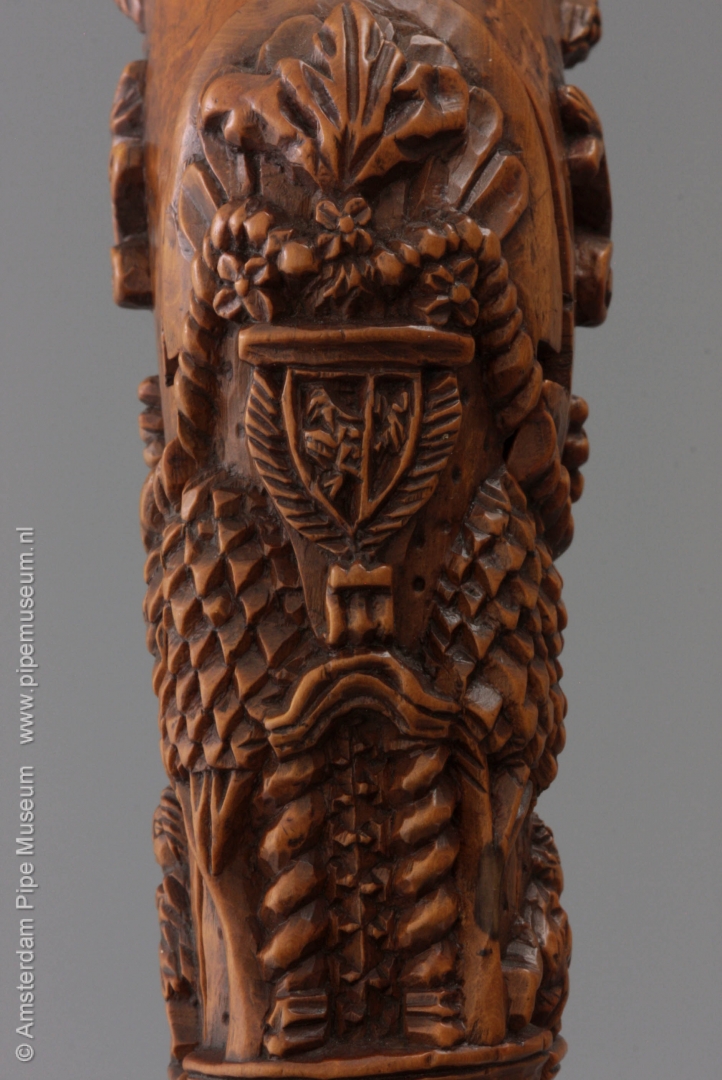
What can we learn when we read the inscription by turning the stem of the pipe case? It reads GENIS 37 VA(R)S 28 BLOKKEN TE MAAKEN DAT IS MIN KIS, DIR OM VOOR ZOEK IK IEDER SEN GVIST RINNERT JAKOBS 1739 (Genesis 37 verse 28 to make blocks that is my job, that is why I ask everybody’s favour Rinnert Jakobs 1739). The first part refers to Biblical text Genesis 37, verse 28 which is about Joseph, the popular son of Jacob who is hated by his brothers. Instead of killing him, the brothers throw him into a well. Eventually Joseph is pulled out of the well by passers-by and sold to the Ishmaelites for twenty shekels of silver. On the pipe case we see the eleven hateful brothers united. Together with the youngest brother Joseph, these are the twelve sons of Jacob, the patriarch. According to tradition, the one from whom the twelve tribes of Israel sprang. The grapevine is a symbol of all the people of Israel and that is exactly what we see here: the rich vines sprout from the, here a little bit bewildered, boys. A beautiful symbolism.
The second part of the text is about the owner of the pipe case, Rinnert Jakobs. An evident Frisian first name and not coincidentally a surname or patronymic that refers directly to the Biblical Jacob. He is a block maker, someone who makes pulley blocks or sheaves. In the inscription he recommends his services and therefore he requests the favor of everyone. That Rinnert is a Frisian is also evident from the coat of arms on the bottom of the pipe case. It is a typical Frisian family coat of arms with a half eagle on the left and another unclear motif on the right. These coats of arms, split in two, serve as a coat of arms for many Frisian families. The carving is beautifully done and still very legible since the pipe case is hardly worn. The carver has obtained a beautiful contrast between the cutouts and the flat background, which has a regular dot pattern. Finally, the stem end has a silver tip with a wavy edge that secures the sliding lid.
The question remains whether Rinnert Jakobs carved the pipe case himself or whether someone did it for him. It is true that a block maker works with wood, but the difference between a coarse pulley and a refined luxury object like this pipe box is very big. Making a pipe case does not only require skilled hands to carve the ornaments, but also the functional side of the pipe case must be mastered. The lid that slides off the pipe case to open and the inner space for the pipe, in a way that the wood mass around the pipe has more or less the same thickness throughout, are all part of the skill of the craft. I cannot imagine that it is Rinnert himself, after sawing blocks and turning pulley sheaves during the day, carved this pipe box in the evening by candlelight as a hobby as it was long believed. More probable he would have purchased such an object from a trained pipe case maker, after they had agreed on the depiction and the inscription in consultation. In this unique object we can still recognize the result of that dialogue.
Amsterdam Pipe Museum APM 20.737
A pipe case with the stations of the cross
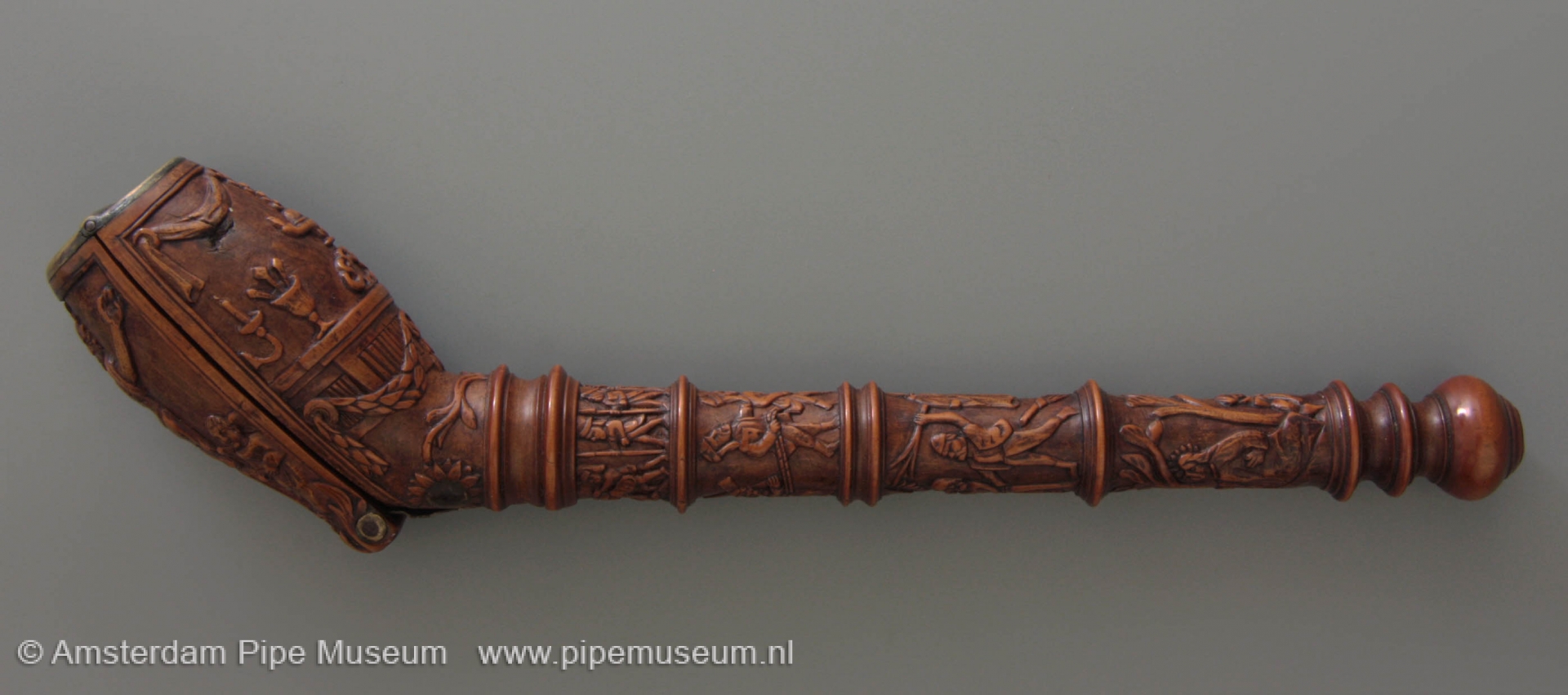
The first cases to safely transport the fragile clay pipe were already made in the seventeenth century. Initially, these so-called pijpenkassen (pipe boxes) were purely functional, intended for the protection of the fragile clay pipe on the way. On top of that, pipe cases are also perfect for decorating with metal, ivory or mother-of-pearl carvings or marquetry. From this urge to decorate, true works of art emerged, which merely served as showpieces and were shown in a display case at home. The pipe case discussed here is such a show object that has hardly been used and has therefore been preserved in pristine condition.
In terms of shape it is a standard pipe case made of walnut, a fine type of wood well suited for making detailed carvings. In this pipe case, the clay pipe is carfully inserted via a hinged cover at the front. The part containing the bowl follows the oval bowl shape of the pipe, the stem is straight and half long. The pipe box is rarely intended for the long standard Gouda pipe of half a meter, but rather for the shorter well finished Sunday pipe with a length of approximately 20 centimeters. A knob at the stem end remains open so that a slightly longer pipe can be slid into the pipe case as well. We see a circular brass hinge on the bowl part, a clamping spring at the bottom to keep the lid closed.
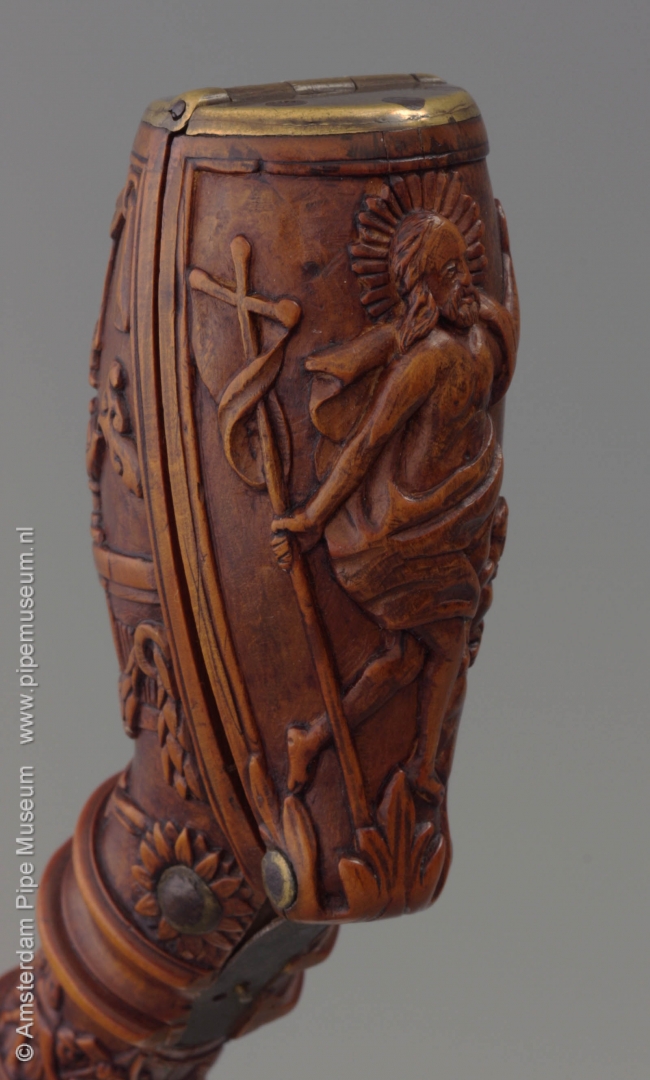
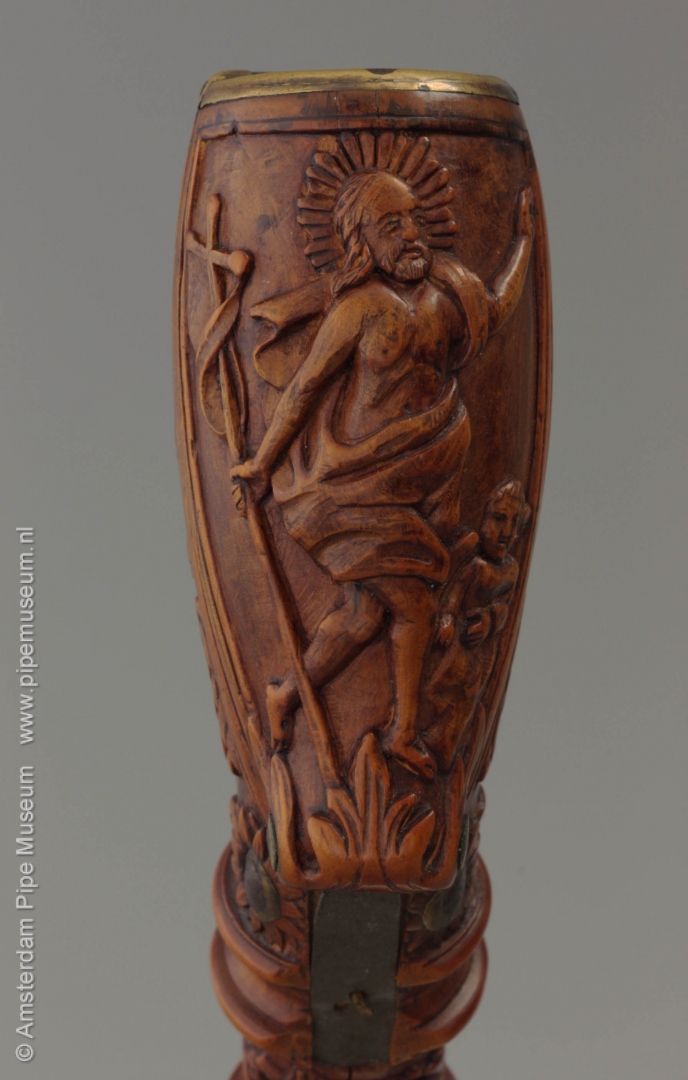
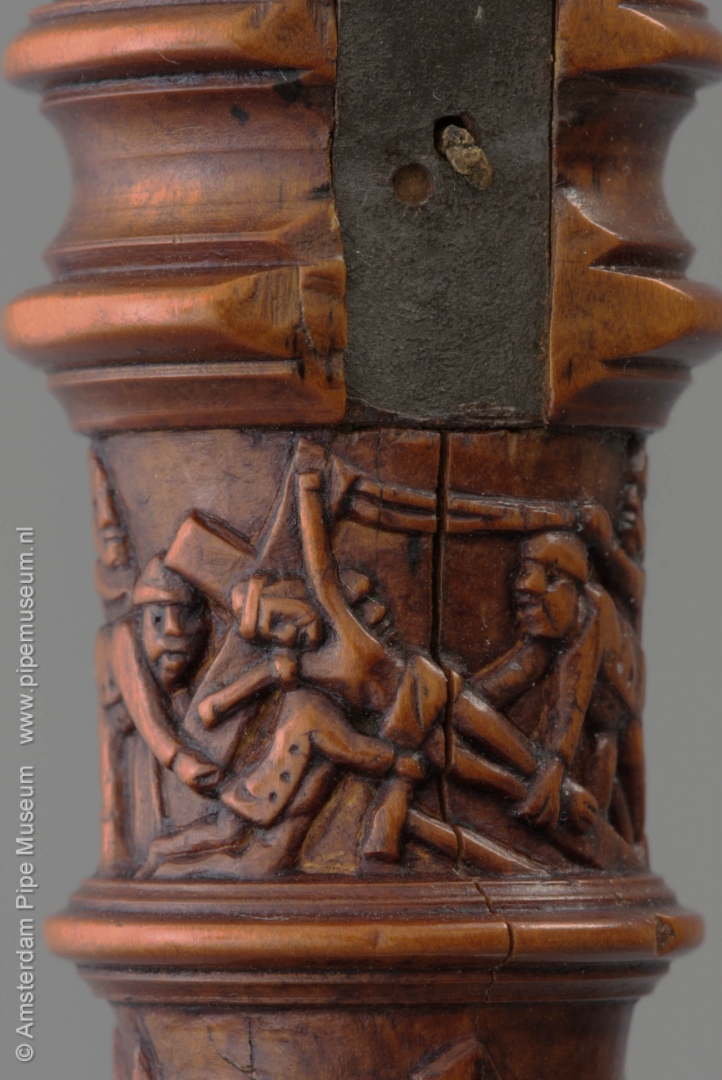
The decoration on this pipe case has a religious theme and is devoted to the suffering of Jesus Christ. Six consecutive scenes illustrate the suffering including the resurrection and call the believer to be vigilant. The lid shows the Triumph of Christ with an aureole, the Roman banner in his right hand, as he rose from the tomb accompanied by a small angel to his left. On the stem side, the image is the symbolic summary of the agony. Here we see an altar with the instruments of passion: a chalice with three nails, the crown of thorns and an oil lamp, symbol of the light of Christ or Lumen Christi.
The stem is decorated as much and shows in bands like a kind of comic strip four scenes from the Way of the Cross of Christ. Each scene is separated by an raised rim around the stem, the last knob is slightly heavier. The story in the stem runs from the stem end to the bowl part. The first scene shows Jesus praying in the garden of Gethsemene amid the sleeping disciples, including Peter with keys. An angel comes from the clouds offering Jesus the chalice, which he requests in his prayer to pass by. Scene two is devoted to the flagellation of Jesus, who is tied unclothed to the column. To underline the prisoner's vulnerability, his cloak hangs behind the men with their scourge. From the top, God the father is overlooking the beating, represented as an eye in the triangle that stands for the Holy Trinity. In picture three, Jesus carries the cross preceded by soldiers. Simon of Cyrene supports him in his heavy task. Finally, in scene four, the cross with Jesus nailed to it is erected by four men. Mourning Mary, completely wrapped in a shapeless robe and one of the disciples watching.
This kind of pipe cases are commonly known as Zeeland pipe-cases (coming from the Dutch Province of Zeeland), especially when it concerns highly decorated pieces, as this one. In the province of Zeeland, the pipe case was seen as part of the traditional costume and a special pocket was even made in the trousers to hold the pipe case. Whether this pipe case is also of Zeeland origin cannot be confirmed. What makes it a little less likely is that this pipe case obviously stems from a Catholic environment because of its theme. Should we therefore rather consider a Flemish origin? However, a reasonably exact date can be given on the basis of the ornamental work around the lamps. This points to a period between 1770 and 1800. As a status symbol, the pipe case will remain in use for at least another century by the Zeeuw who remains faithful to his costume. Even today it is still a topical object to show off.
Amsterdam Pipe Museum APM 19.865